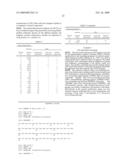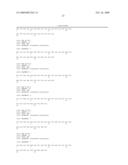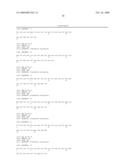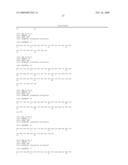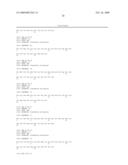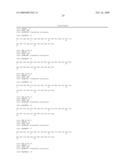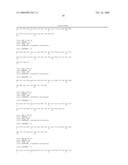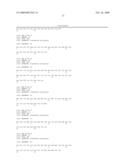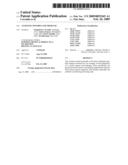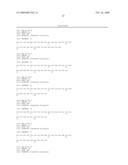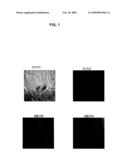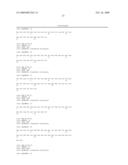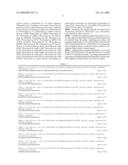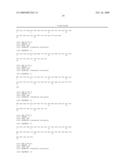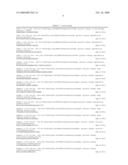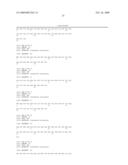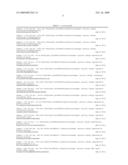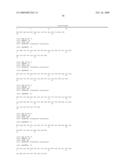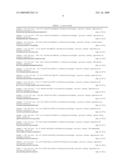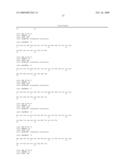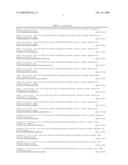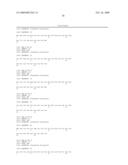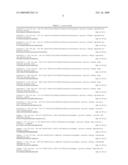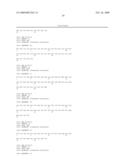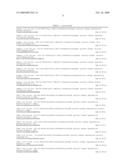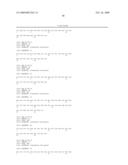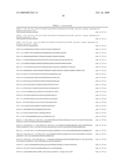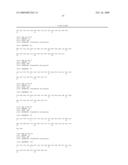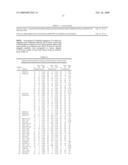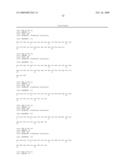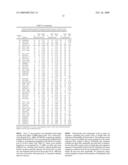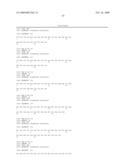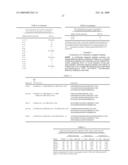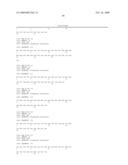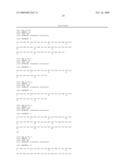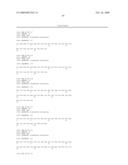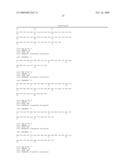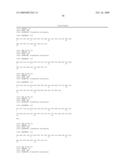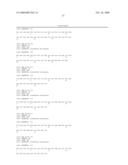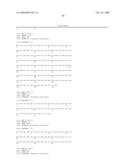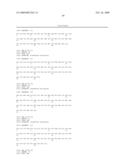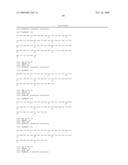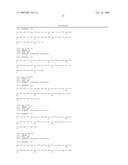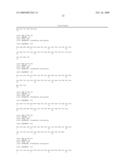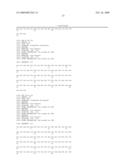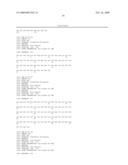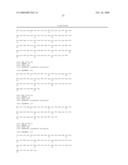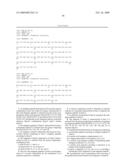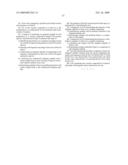Patent application title: Antigenic peptides and their use
Inventors:
Giampietro Corradin (Epalinges, CH)
Andrey Kajava (Montpellier Cedex, FR)
Pierre Druilhe (Paris, FR)
Ali Jafarshad (Paris, FR)
IPC8 Class: AA61K39015FI
USPC Class:
4242721
Class name: Parasitic organism or component thereof or substance produced by said parasitic organism (e.g., schistosoma, dirofilaria, trichinella, fasciola, ancylostoma, ascaris, etc.) parasitic protozoan (e.g., trypanosoma, trichomonas, leishmania, entamoeba, etc.) plasmodium
Publication date: 2009-02-26
Patent application number: 20090053265
Claims:
1. An antigenic peptide deriving from Plasmodium species comprising at
least one coiled coil region, characterized in that said antigenic
peptide is selected from the group comprising the amino acid sequences
SEQ ID NO 1 to 132, SEQ ID NO 134 to SEQ ID NO 153 and SEQ ID NO 159 to
SEQ ID NO 163, biologically active fragments thereof, molecular chimeras
thereof, combinations thereof and/or variants thereof.
2. The antigenic peptide of claim 1, characterized in that a combination thereof is selected from the group comprising the SEQ ID NO 154, 155, 156, 157 and 158.
3. An antigenic cocktail composition deriving from Plasmodium species comprising at least 2 antigenic peptides according to claim 1.
4. The antigenic cocktail composition of claim 3 characterized in that it is selected from the group comprising a combination withi) SEQ ID NO 1, 2 and 3, orii) SEQ ID NO 16, 33, 38 and 2 oriii) SEQ ID NO 35, 27, 4, 34, 24, and 37.
5. The use of the antigenic peptide of claim 1 in the preparation of a vaccine composition for the stimulation of an immune response in a mammal.
6. A vaccine composition useful to stimulate an immune response in a mammal characterized in that it comprises the antigenic peptide of claim 1.
7. An antibody characterized in that it recognizes the antigenic peptide of claim 1.
8. The antibody of claim 7, characterized in that it is selected from the group comprising an antibody recognizing an antigenic peptide of SEQ ID NO 8, 9, 11/12, 13, 14, 27, 86, 102, 99, 68, 41, 110, 78, 135, 136, 138, 146 and 151 or mixtures thereof.
9. A purified and isolated nucleic acid sequence comprisingi) a nucleotide sequence encoding an antigenic peptide of claim 1,ii) a nucleic acid sequence complementary to i),iii) a degenerated nucleic acid sequence of i) or ii),iv) a nucleic acid sequence capable of hybridizing under stringent conditions to i), ii) or iii),v) a nucleic acid sequence encoding a truncation or an analog of the antigenic peptidevi) and/or a fragment of i), ii), iii), iv) or v) encoding a biologically active fragment of said antigenic peptide.
10. An expression vector comprising at least one copy of the purified and isolated nucleic acid sequence of claim 9.
11. A host cell comprising a purified and isolated nucleic acid sequence of claim 9.
12. Use of the vaccine composition of claim 6, in the manufacture of a medicament for the treatment and/or prevention of malaria.
13. A method of producing an antigenic peptide for the preparation of a vaccine composition against Plasmodium species, characterized in that it comprises the steps of:a) identifying the presence of a sequence encoding at least one coiled coil region in the genome of said Plasmodium species,b) selecting said sequence encoding at least one coiled coil region,c) synthesizing an antigenic peptide corresponding to the sequence containing the at least one coiled coil region selected in step b),d) contacting the synthesized antigenic peptide with a serum sample from at least one donor living in Plasmodium species endemic areas; ande) determining whether at least one antibody present in said serum sample binds to the synthesized antigenic peptide.
14. The method of claim 13, characterized in that step a) is performed by a bioinformatic tool.
15. A diagnostic tool for determining the presence of the antigenic peptide of claim 1 in a sample comprising:i) contacting the sample with an antibody directed to the antigenic peptide, andii) determining whether said antibody binds to a component of said sample.
16. A diagnostic tool for determining the presence of antibodies to peptide of claim 1 in a sample comprising:i) contacting said sample with the antigenic peptide of claim 1, andii) determining whether antibodies bind to a component of said antigenic peptide.
17. A protein characterized in that it comprises at least one antigenic peptide selected from the group comprising the amino acid sequences SEQ ID NO 2 to SEQ ID NO 37, SEQ ID NO 39 to 132, SEQ ID NO 134 to SEQ ID NO 146, SEQ ID NO 148 to SEQ ID NO 153 and SEQ ID NO 159 to SEQ ID NO 163.
18. A kit comprising the vaccine composition of claim 6, optionally with reagents and/or instructions for use.
Description:
FIELD OF THE INVENTION
[0001]This invention relates generally to the field of pathogen peptidic antigens and their use, for example, for the preparation of a vaccine against said pathogen. More specifically, the present invention relates to an antigenic peptide deriving from plasmodium species sequences, and includes antibodies and methods of producing and using same.
BACKGROUND OF THE INVENTION
[0002]Human Plasmodium falciparum (Pf) is a public health problem. Today approximately 40% of the world's population mostly those living in the poorest countries are at risk of malaria. Malaria causes more than 300 million acute illnesses and at least one million deaths annually. 90% of deaths due to malaria occur in sub-Saharan African countries mostly among young children and pregnant women (http://rbm.who.int).
[0003]Unfortunately, vaccine discovery is still a very empirical process given that protective antigens do not bear any structural, physicochemical or sequence related characteristics that would allow their identification. The only constraint for antigens whose protective capacity is antibody mediated is their accessibility to antibody molecules. Initially, vaccine development was performed with intact microorganisms or proteins, which were easily obtainable through classical purification methods. Introduction of molecular biology techniques generally improved the antigen isolation step, but difficulty in producing highly purified recombinant proteins in milligram amounts still remains; this renders this approach very costly and not adaptable to high throughput screening methods. Furthermore, proper protein folding still represents an additional problem in numerous cases. Thus, overcoming the bottlenecks of manufacturing and identification of proteins as targets of protection represents a grand challenge to the scientific community.
[0004]In the past 20 years huge efforts have been made to develop a malaria vaccine with over 40 phase I and II trials being conducted (Ballou et al, 2004, Van de Perre and Dedet, 2004). Currently, there are approximately 70 different vaccine candidates under development with at least 10 in clinical trials. The antigens used are derived from various stages of the parasite life cycle (Genton and Corradin, 2002, Ballou et al, 2004), with various immunisation regimens (Dunachie and Hill, 2003) and combined with different adjuvants formulated in various delivery systems (Genton et al, 2002; Taylor-Robinson, 2003; Ballou et al, 2004).
[0005]Results obtained in clinical trials conducted in endemic situations were encouraging and showed some levels of protection (Bojang et al, 1998, Bojang et al, 2001, Gentonet et al, 2002) while other trials showed no protection (Nosten et al, 1996, Valero et al, 1996, Urdaneta et al, 1998, Graves and Gelband, 2004). To date, the most advanced malaria vaccine is RTS,S/AS02A. This vaccine comprises a large portion of the immunologically dominant NANP repeats of the circumsporozoite protein and a portion of the C-terminal region containing T cell epitopes, which is fused to hepatitis B surface antigen (Gordon et al, 1995), co-expressed in Saccharomyces cerevisiae and formulated with the strong adjuvant AS02A (Stoute et al, 1997). RTS,S/AS02A targets the pre-erythrocytic liver stage and protects against both clinical malaria and parasitaemia in naive (Stoute et al, 1997) and malaria exposed adult males (Bojang et al, 2001), although for a short period. In addition, better protection level against clinical malaria has been obtained in toddlers in a recently completed trial in Mozambique (Alonso et al, 2004). Protection was sustained for up to 6 months in children, which are the most affected by the disease.
[0006]The vaccine candidates that have been used to date have not been systematically selected for their ability to protect; most of the parasite molecules were empirically prioritised following their chronological order of discovery. This approach though successful for other pathogens, has not been able to provide an effective malaria vaccine.
[0007]For example, EP 0315 0185 B1 (in the name of Behringwerke aktiengesellschaft) described the isolation of a gene which codes for a histidine/alanine-rich protein by screening two different Plasmodium falciparum cDNA gene banks with antiserum against a 41 kDa protein and by cross-hybridisation with the insert DNA of a clone obtained therewith. The isolated protein protected Aotus monkeys from infection with Plasmodium falciparum. Unfortunately, this approach had not lead to the development of an efficient vaccine in humans probably due to the fact that these monkeys are not the appropriate models to mimic human immunological response to Plasmodium falciparum.
[0008]In an attempt to develop vaccines against another pathogen, Streptococcus pneumoniae, mapping studies using monoclonal antibodies raised against pneumococcal surface protein A (PspA) indicated that the major cross-reactive epitopes are found in the last 100 amino-acids of the coiled-coil domain which is an important structural and biologically abundant domain found in diverse group of proteins (Chen and Parry, 1986 and 1990).
[0009]Pursuant to this finding, International Patent Application WO00/37105 (in the name of Medimmune, Inc.) disclosed a process and a vaccine composition for preventing infection caused by Streptococcus pneumoniae that comprises polypeptides and fragments of polypeptides containing histidine triad residues or coiled-coil regions.
[0010]More recently, International Patent Application WO01/96368 (in the name of Cytovax Biotechnologies, Inc.) disclosed the use of a coiled-coil structural scaffold to generate structure-specific peptides, including synthetic peptides. These synthetic peptides are useful as vaccines or to stimulate antibody production or cell-mediated immunity to the naturally occurring pneumococcal surfaces proteins A and C.
[0011]Although there has been some progress in the treatment of malaria, the development of a safe and effective malaria vaccine remains an urgent unmet medical need for vast populations living in malaria-endemic region.
[0012]This object has been achieved by providing a new antigenic peptide deriving from Plasmodium species comprising at least one coiled coil region. This peptide has been prepared according to a method of producing an antigenic peptide for the preparation of a vaccine against a pathogen based on a new approach for identifying the presence of a sequence encoding at least one coiled-coil region in the genome of said pathogen.
SUMMARY OF THE INVENTION
[0013]These and other objects as will be apparent from the foregoing have been achieved by providing a new antigenic peptide deriving from Plasmodium species comprising at least one coiled coil region, characterized in that said antigenic peptide is selected from the group comprising the amino acid sequences SEQ ID NO 1 to 132, SEQ ID NO 134 to SEQ ID NO 153 and SEQ ID NO 159 to SEQ ID NO 163, biologically active fragments thereof, molecular chimeras thereof, combinations thereof and/or variants thereof.
[0014]Another object of the invention is to provide an antigenic cocktail composition deriving from Plasmodium species.
[0015]This invention also contemplates the use of the antigenic peptide deriving from Plasmodium species or of the antigenic cocktail composition in the preparation of a vaccine composition useful to stimulate an immune response in a mammal and the use thereof in the manufacture of a medicament for the treatment and/or prevention of malaria
[0016]A further object of the present invention is to provide an antibody that recognizes the antigenic peptide of or the antigenic cocktail composition deriving from Plasmodium species.
[0017]The present invention also relates to a purified and isolated nucleic acid sequence comprising a nucleotidic sequence encoding the antigenic peptide deriving from Plasmodium species, an expression vector comprising at least one copy of said purified and isolated nucleic acid sequence, and a host cell comprising either the purified and isolated nucleic acid sequence or the expression vector.
[0018]The present invention further relates to a method of producing an antigenic peptide for the preparation of a vaccine composition against a pathogen.
[0019]A diagnostic tool for determining the presence of the antigenic peptide or antibodies directed against said antigenic peptide is also contemplated in the present invention
[0020]Other objects and advantages will become apparent to those skilled in the art from a review of the ensuing detailed description, which proceeds with reference to the following illustrative drawings, and the attendant claims.
BRIEF DESCRIPTION OF THE FIGURES
[0021]FIG. 1 represents the immunofluorence data obtained on infected human erythrocytes using affinity purified human antibodies against SEQ ID NO 34 (P1577), SEQ ID NO 4 (P1574), SEQ ID NO 133 (MR198) and SEQ ID NO 1 (MR194).
DETAILED DESCRIPTION OF THE INVENTION
[0022]The present invention relates to an antigenic peptide deriving from Plasmodium species comprising at least one coiled coil region from a Plasmodium species sequence.
[0023]The term "comprising" is generally used in the sense of including, that is to say permitting the presence of one or more features or components.
[0024]As used herein, the terms "protein", "polypeptide", "polypeptidic", "peptide" and "peptidic" are used interchangeably herein to designate a series of amino acid residues connected to the other by peptide bonds between the alpha-amino and carboxy groups of adjacent residues.
[0025]The term "antigenic peptide" refers to a peptide that is recognized by an antibody. Usually, the immune response results in the production of antibodies recognizing the antigenic peptide or at least a part thereof.
[0026]In the present context, the term "deriving" refers to the fact that the antigenic peptide has been selected among the amino acid sequences present in the Plasmodium species pathogen sequence.
[0027]"Coiled coil region", "coiled-coil domain" or "region" are usually made up of amino acid sequence having heptad (abcdefg) repeats with apolar residues at the a and b positions and typically polar residues elsewhere. The structure of these regions are stabilized by hydrophobic interactions between the a and d positions in the different strands (Hodges et al, 1981; Hodges, 1996).
[0028]"Plasmodium species" as used herein can be selected among the following plasmodium strains:
Plasmodium agamae, Plasmodium atheruri, Plasmodium azurophilum, Plasmodium berghei, Plasmodium brasilianum, Plasmodium cathemerium, Plasmodium chabaudi, Plasmodium chiricahuae, Plasmodium coatneyi, Plasmodium cuculus, Plasmodium cynomolgi, Plasmodium elongatum, Plasmodium fairchildi, Plasmodium falciparum, (such as Plasmodium falciparum (isolate 311), Plasmodium falciparum (isolate 7G8), Plasmodium falciparum (isolate CAMP/Malaysia), Plasmodium falciparum (isolate CDC/Honduras), Plasmodium falciparum (isolate DD2), Plasmodium falciparum (isolate FC27/Papua New Guinea), Plasmodium falciparum (isolate FcB1/Columbia), Plasmodium falciparum (isolate FCBR/Columbia), Plasmodium falciparum (isolate FCH-5), Plasmodium falciparum (isolate FCM17/Senegal), Plasmodium falciparum (isolate FCR-3/Gambia), Plasmodium falciparum (isolate fid3/india), Plasmodium falciparum (isolate hb3), Plasmodium falciparum (isolate IMR143), Plasmodium falciparum (isolate K1/Thailand), Plasmodium falciparum (isolate KF1916), Plasmodium falciparum (isolate LE5), Plasmodium falciparum (isolate mad20/papua new guinea), Plasmodium falciparum (isolate mad71/papua new guinea), Plasmodium falciparum (isolate NF54), Plasmodium falciparum (isolate NF7/Ghana), Plasmodium falciparum (isolate nig32/nigeria), Plasmodium falciparum (isolate PALO ALTO/UGANDA), Plasmodium falciparum (isolate RO-33/Ghana), Plasmodium falciparum (isolate T4/Thailand), Plasmodium falciparum (isolate TAK 9), Plasmodium falciparum (isolate thtn/thailand), Plasmodium falciparum (isolate V1), Plasmodium falciparum (isolate WELLCOME), Plasmodium falciparum 3D7), Plasmodium fieldi, Plasmodium floridense, Plasmodium fragile, Plasmodium gallinaceum, Plasmodium giganteum, Plasmodium gonderi, Plasmodium guanggong, Plasmodium heteronucleare, Plasmodium hylobati, Plasmodium inui, Plasmodium juxtanucleare, Plasmodium knowlesi, Plasmodium lophurae, Plasmodium malariae, Plasmodium cf. malariae, Plasmodium mexicanum, Plasmodium nucleophilum, Plasmodium ovale, (malaria parasite P. ovale), Plasmodium reichenowi, Plasmodium relictum, Plasmodium rouxi, Plasmodium simiovale, Plasmodium simium, Plasmodium vinckei, Plasmodium vivax (such as Plasmodium vivax (strain Belem) Plasmodium vivax (strain Salvador I)), Plasmodium yoelii, Plasmodium sp. unclassified such as Plasmodium sp. 909413, Plasmodium sp. 909414, Plasmodium sp. 909415, Plasmodium sp. 909416, Plasmodium sp. AP61, Plasmodium sp. AP62, Plasmodium sp. AP63, Plasmodium sp. AP64, Plasmodium sp. AP65, Plasmodium sp. AP66, Plasmodium sp. AP67, Plasmodium sp. AP68, Plasmodium sp. AP69, Plasmodium sp. AP70, Plasmodium sp. AP71, Plasmodium sp. AP72, Plasmodium sp. AP73, Plasmodium sp. AP74, Plasmodium sp. AP75, Plasmodium sp. AP76, Plasmodium sp. AP77, Plasmodium sp. AP78, Plasmodium sp. C1, Plasmodium sp. C2, Plasmodium sp. C3, Plasmodium sp. COLL1, Plasmodium sp. D1, Plasmodium sp. DAJ-2004, Plasmodium sp. E1, Plasmodium sp. E2, Plasmodium sp. ex Aplonis atrifusca, Plasmodium sp. ex Aplonis tabuensis, Plasmodium sp. ex Foulehaio carunculata, Plasmodium sp. ex Halcyon chloris, Plasmodium sp. ex Myzomela cardinalis, Plasmodium sp. ex Ptilinopus porphyraceus, Plasmodium sp. F1, Plasmodium sp. G1, Plasmodium sp. GRW11, Plasmodium sp. GRW2, Plasmodium sp. GRW4, Plasmodium sp. H1, Plasmodium sp. ORW1, Plasmodium sp. PA, Plasmodium sp. PARUS2, Plasmodium sp. PB, Plasmodium sp. pBT6, Plasmodium sp. pBT7, Plasmodium sp. pBT8, Plasmodium sp. pBT9, Plasmodium sp. PC, Plasmodium sp. pGRW9, Plasmodium sp. PH, Plasmodium sp. PI, Plasmodium sp. PU1, Plasmodium sp. SGS1, Plasmodium sp. strain KZ02, Plasmodium sp. strain LA09, Plasmodium sp. strain LA15, Plasmodium sp. strain OZ01A, Plasmodium sp. strain OZ04, Plasmodium sp. strain OZ08, Plasmodium sp. strain OZ14, Plasmodium sp. strain OZ25, Plasmodium sp. strain OZ35, Plasmodium sp. strain OZ35A, Plasmodium sp. strain OZ35B, Plasmodium sp. strain OZ36A, Plasmodium sp. strain OZ42, Plasmodium sp. strain OZ45, Plasmodium sp. strain OZ46, Plasmodium sp. strain PR01, Plasmodium sp. SYAT24, Plasmodium vivax-like sp).
[0029]Preferably, the antigenic peptide will derive from Plasmodium falciparum, Plasmodium vivax, Plasmodium ovale and Plasmodium malariae.
[0030]Usually, the antigenic peptide deriving from Plasmodium species comprising at least one coiled coil region will be selected from the group comprising the amino acid sequences SEQ ID NO 1 to 132, SEQ ID NO 134 to SEQ ID NO 153 and SEQ ID NO 159 to SEQ ID NO 163, biologically active fragments thereof, molecular chimeras thereof, combinations thereof and/or variants thereof.
[0031]Applicants have selected SEQ ID NO 1 to 132, SEQ ID NO 134 to SEQ ID NO 153 and SEQ ID NO 159 to SEQ ID NO 163, represented in table 1, according to the method of producing an antigenic peptide described infra. All these peptidic sequences contain at least one coiled coil region.
TABLE-US-00001 TABLE 1 Sanger_1 3.030 303 pos. 497-559 Pfa3D7|pfa1_chr1|PFA0170c|Annotation|Sanger (protein coding) hypotheti- cal protein, cons VNNLDSTVNYMNSTGNNINNIVNNLDSTVNYMNSTGNNINNIVNNLDSTVNYMNSTGNNINNI (SEQ ID No1) Sanger 3.250 325 pos. 437-473 Pfa3D7|pfa1_chr1|PFA0635c|Annotation|Sanger (protein coding) hypothetical protein Location NHDTRINDYNKRLTEYNKRLTEYNKRLTEYTKRLNE (SEQ ID No39) TIGR_1 3.320 332 pos. 140-166 Pfa3D7|pfa1_chr2|PFB0145c|Annotation|TIGR (protein coding) hypothetical protein Location TISSLSNKIVNYESKIEELEKELKEVK (SEQ ID No2) TIGR_2 3.090 309 pos. 249-273 Pfa3D7|pfa1_chr2|PFB0145c|Annotation|TIGR (protein coding) hypothetical protein Location IIDIKKHLEKLKIEIKEKKEDLENL (SEQ ID No5) TIGR_3 3.640 364 pos. 575-601 Pfa3D7|pfa1_chr2|PFB0145c|Annotation|TIGR (protein coding) hypothetical protein Location NIKTMNTQISTLKNDVHLLNEQIDKLN (SEQ ID No3) TIGR_4 2.930 293 pos. 537-561 Pfa3D7|pfa1_chr2|PFB0145c|Annotation|TIGR (protein coding) hypothetical protein Location INNLNEKLEETNKEYTNLQNNYTNE (SEQ ID No6) TIGR_6 2.710 271 pos. 597-621 Pfa3D7|pfa1_ch2|PFB0145c|Annotation|TIGR (protein coding) hypothetical protein Location IDKLNNEKGTLNSKISELNVQIMDL (SEQ ID No7) TIGR_7 3.000 300 pos. 999-1023 Pfa3D7|pfa1_chr2|PFB0145c|Annotation|TIGR (protein coding) hypothetical protein Location LLSKDKEIEEKNKKIKELNNDIKKL (SEQ ID No9) TIGR_8 2.800 280 pos. 1154-1178 Pfa3D7|pfa1_chr2|PFB0145c|Annotation|TIGR (protein coding) hypothetical protein Location ICSLTTEVMELNNKKNELIEENNKL (SEQ ID No11) TIGR_9 2.690 269 pos. 1126-1150 Pfa3D7|pfa1_chr2|PFB0145c|Annotation|TIGR (protein coding) hypothetical protein Location VDKIEEHILDYDEEINKSRSNLFQLKNE (SEQ ID No12) TIGR_10 4.050 405 pos. 1198-1224 Pfa3D7|pfa1_chr2|PFB0145c|Annotation|TIGR (protein coding) hypotheti- cal protein Location EIEKLNKQLTKCNKQIDELNEEVEKLN (SEQ ID No4) TIGR_11 2.670 267 pos. 1178-1202 Pfa3D7|pfa1_chr2|PFB0145c|Annotation|TIGR (protein coding) hypotheti- cal protein Location LNLVDQGKKKLKKDVEKQKKEIEKL (SEQ ID No10) TIGR_12 2.600 260 pos. 1252-1276 Pfa3D7|pfa1_chr2|PFB0145c|Annotation|TIGR (protein coding) hypotheti- cal protein Location LDENEDNIKKMKSKIDDMEKEIKYR (SEQ ID No13) TIGR 3.170 317 pos. 1603-1627 Pfa3D7|pfa1_chr2|PFB0315w|Annotation|TIGR (protein coding) 41 kDa antigen Location = 281907. MEQMDMKMEKIDVNMDQMDVKMEQM (SEQ ID No40) TIGR 3.020 302 pos. 616-645 Pfa3D7|pfa1_chr2|PFB0460c|Annotation|TIGR (protein coding) hypothetical protein Location = co NNVIRSKMYNIKKRISKINDELHELSNFFL (SEQ ID No41) TIGR_1 3.160 316 pos. 516-540 Pfa3D7|pfa1_chr2|PFB0765w|Annotation|TIGR (protein coding) hypothetical protein Location LEEMKQKNKELINNLNDISDELKNC (SEQ ID No42) TIGR_2 3.470 347 pos. 605-633 Pfa3D7|pfa1_chr2|PFB0765w|Annotation|TIGR (protein coding) hypothetical protein Location EKLNDMQKKLNDVNEKYKNIVECLNNYKT (SEQ ID No43) TIGR_3 3.370 337 pos. 1074-1098 Pfa3D7|pfa1_chr2|PFB0765w|Annotation|TIGR (protein coding) hypothetical protein Location LKEKDKKINDLMKDMEKKKEEINKL (SEQ ID No44) Sanger 3.340 334 pos. 798-837 Pfa3D7|pfa1_chr3|PFC0235w|Annotation|Sanger (protein coding) hypothetical protein Locat NEIKELNNTLNKYKEEMNNYKEEIIVINEKYKLLEIELCK (SEQ ID No45) Sanger_1 4.000 400 pos. 2215-2255 Pfa3D7|pfa1_chr3|PFC0245c|Annotation|Sanger (protein coding) hypo- thetical protein Location GMNNMNGDINNINGDINNMNGDINNMNGDINNMNGDINNMN (SEQ ID No14) Sanger_1 3.220 322 pos. 285-309 PFA3D7|pfa1_chr3|PFC0345w|Annotation|Sanger (protein coding) hypotheti- cal protein Locat MNIMENDMNIMENDMNIIKNDMNIM (SEQ ID No46) Sanger_2 3.140 314 pos. 306-330 Pfa3D7|pfa1_chr3|PFC0345w|Annotation|Sanger (protein coding) hypotheti- cal protein Locat MNIMEKDMNIIKNDMNIIKNNMNII (SEQ ID No47) Sanger_1 3.020 302 pos. 2208-2236 Pfa3D7|pfa1_chr3|PFC0760c|Annotation|Sanger (protein coding) hypo- thetical protein Locat EEIYKLNNDIDMLSNNCKKLKESIMMMEK (SEQ ID No48) Sanger_2 3.430 343 pos. 2401-2429 Pfa3D7|pfa1_chr3|PFC0760c|Annotation|Sanger (protein coding) hypo- thetical protein Locat KEIQMLKNQILSLEESIKSLNEFINNLKN (SEQ ID No49) Sanger 3.640 364 pos. 180-210 Pfa3D7|pfa1_chr3|PFC0810c|Annotation|Sanger(protein coding) hypothetical protein Locatio KNVIELKEYLEDLKKRMFDMQKRLNDIIITK (SEQ ID No50) Sanger_1 3.010 301 pos. 1256-1280 Pfa3D7|pfa1_chr3|PFC0960c|Annotation|Sanger (protein coding) hypo- thetical protein Locat IETLENNLKIGKEKINKFDNEIQKL (SEQ ID No51) Sanger_4 3.160 316 pos. 1707-1731 Pfa3D7|pfa1_chr3|PFC0960c|Annotation|Sanger (protein coding) hypo- thetical protein Locat INNMKEQIEDVNHKIASINKEKEEL (SEQ ID No52) Sanger_1 2.620 262 pos. 758-782 Pfa3D7|pfa1_chr4|PFD0110w|Annotation|Sanger (protein coding) reticulo- cyte binding protein DEKINDYLEEIKNEQNKIDKTIDDI (SEQ ID No19) Sanger_2 3.270 327 pos. 813-839 Pfa3D7|pfa1_chr4|PFD0110w|Annotation|Sanger (protein coding) reticulo- cyte binding protein LIKYMNERYQNMQQGYNNLTNYINQYE (SEQ ID No15) Sanger_3 2.670 267 pos. 1396-1420 Pfa3D7|pfa1_chr4|PFD0110w|Annotation|Sanger (protein coding) reticulocyte binding protein MDVVINQLRDIDRQMLDLYKELDEK (SEQ ID No20) Sanger_4 3.090 309 pos. 1814-1840 Pfa3D7|pfa1_chr4|PFD0110w|Annotation|Sanger (protein coding) reticulocyte binding protein DINSTNNNLDNMLSEINSIQNNIHTYI (SEQ ID No16) Sanger_5 3.180 318 pos. 1904-1925 Pfa3D7|pfa1_chr4|PFD0110w|Annotation|Sanger (protein coding) reticulocyte binding protein EKKLDILKVNISNINNSLDKLK (SEQ ID No17) Sanger_6 2.620 262 pos. 1933-1957 Pfa3D7|pfa1_chr4|PFD0110w|Annotation|Sanger (protein coding) reticulocyte binding protein FQKVKEKAEIQKENIEKIKQEINTL (SEQ ID No23) Sanger_7 3.250 325 pos. 2070-2096 Pfa3D7|pfa1_chr4|PFD0110w|Annotation|Sanger (protein coding) reticulocyte binding protein DVHNIKEDYNLLQQYLNYMKNEMEQLK (SEQ ID No18) Sanger_8 2.930 293 pos. 2208-2232 Pfa3D7|pfa1_chr4|PFD0110w|Annotation|Sanger (protein coding) reticulocyte binding protein ISNIFKDIQNIKKQSQDIITNMNDM (SEQ ID No21) Sanger_9 2.950 295 pos. 2359-2383 Pfa3D7|pfa1_chr4|PFD0110w|Annotation|Sanger (protein coding) reticulocyte binding protein LEEIIKNLDILDEQIMTYHNSIDEL (SEQ ID No22) Sanger 3.170 317 pos. 35-59 Pfa3D7|pfa1_chr4|PFD0330w|Annotation|Sanger (protein coding) hypothetical protein Location LKELEKKNDILSNDKNQLQKNLTQL (SEQ ID No53) Sanger 3.490 349 pos. 68-92 Pfa3D7|pfa1_chr4|PFD0520c|Annotation|Sanger (protein coding) hypothetical protein Location LSEGNKELEKLEKNIKELEETNNTL (SEQ ID No54) Sanger 3.160 316 pos. 1201-1225 Pfa3D7|pfa1_chr4|PFD0545w|Annotation|Sanger (protein coding) hypotheti- cal protein Location LNHLTNNLSHHNNHMNHHTSNLNHI (SEQ ID No55) Sanger 3.760 376 pos. 779-816 Pfa3D7|pfa1_chr4|PFD0685c|Annotation|Sanger (protein coding) chromosome associated protein STDINSLNDEVKKLKEELNKIRNEYDDFKNKLELLYQK (SEQ ID No56) Sanger 3.970 397 pos. 1434-1458 Pfa3D7|pfa1_chr4|PFD0970c|Annotation|Sanger (protein coding) hypotheti- cal protein Location INNMDEKINNVDEQNNNMDEKINNV (SEQ ID No57) Sanger 4.590 459 pos. 2083-2116 Pfa3D7|pfa1_chr4|PFD0985w|Annotation|Sanger (protein coding) hypotheti- cal protein Location DNNVNNMDNNVNNVDNNVNNVDNNLNNVDNNVNN (SEQ ID No58) Sanger_1 3.250 325 pos. 780-813 Pfa3D7|pfa1_chr4|PFD1115c|Annotation|Sanger (protein coding) hypotheti- cal protein Locat DVTHLTNDVTHLTNDVTHLTNDVTHLTNDVTHLT (SEQ ID No25) Sanger 3.040 304 pos. 193-221 Pfa3D7|pfa1_chr5|PFE0100w|Annotation|Sanger (protein coding) hypothetical protein Location TLIDSFNLNLSYLRESINNKKKHINKIND (SEQ ID No59) Sanger 3.250 325 pos. 1012-1036 Pfa3D7|pfa1_chr5|PFE0130c|Annotation|Sanger (protein coding) hypotheti- cal protein Location LLNLQNDIQKKNKTLEELGEEIQKY (SEQ ID No60) Sanger 3.470 347 pos. 1920-1946 Pfa3D7|pfa1_chr5|PFE0570w|Annotation|Sanger (protein coding) hypotheti- cal protein Locat NLNKVKININDLNNNIVDVNNSIHNIE (SEQ ID No26) Sanger 3.140 314 pos. 1-33 Pfa3D7|pfa1_chr5|PFE0595w|Annotation|Sanger (protein coding) hypothetical protein Locatio MSQEKISEIIKDISALKTSCEKLNSQLDELITQ (SEQ ID No61) Sanger_1 2.890 289 pos. 481-505 Pfa3D7|chr6|MAL6P1.37|Annotation|Sanger (protein coding) hypothetical protein Location YIDIKKKISELQKDNESLKIQVDRL (SEQ ID No28) Sanger_2 3.250 325 pos. 845-871 Pfa3D7|chr6|MAL6P1.37|Annotation|Sanger (protein coding) hypothetical protein Location KKRNVEEELHSLRKNYNIINEEIEEIT (SEQ ID No27) Sanger 3.060 306 pos. 1399-1423 Pfa3D7|chr6|MAL6P1.44|Annotation|Sanger
(protein coding) hypothetical protein Location = co FNDVTSNVGNMNNNLTNFSNPYNSV (SEQ ID No62) Sanger 3.580 358 pos. 966-1002 Pfa3D7|chr6|MAL6P1.61|Annotation|Sanger (protein coding) DNA repair protein RAD50, putati IPLNQKVLEISKKLNNMNNNINEYKNYLSNFIHMLKE (SEQ ID No63) Sanger 4.600 460 pos. 1734-1760 Pfa3D7|chr6|MAL6P1.80|Annotation|Sanger (protein coding) hypothetical protein Location = 37 NNINNINNNINNINNNINNINNNINNINNNVNNYY (SEQ ID No64) Sanger 3.110 311 pos. 1436-1460 Pfa3D7|chr6|MAL6P1.307|Annotation|Sanger (protein coding) hypothetical protein Location MNNMNNNMNNLNNSINNNNMNNINV (SEQ ID No65) Sanger 3.220 322 pos. 525-549 Pfa3D7|chr6|MAL6P1.272|Annotation|Sanger (protein coding) ribonuclease, putative Location LKKKDEEIKHLNESIYILQQNMNNL (SEQ ID No66) Sanger 3.320 332 pos. 14-38 Pfa3D7|chr6|MAL6P1.254|Annotation|Sanger (protein coding) hypothetical protein Location FDAYNEKLGSISQSIDEIKKKIDNL (SEQ ID No67) Sanger 3.080 308 pos. 7581-7613 Pfa3D7|chr6|MAL6P1.147|Annotation|Sanger (protein coding) hypothetical protein Location = c DSMNNHKDDMNNYNDNINNYVESMNNYDDIMNK (SEQ ID No68) Sanger 3.570 357 pos. 3412-3441 Pfa3D7|chr6|MAL6P1.131|Annotation|Sanger (protein coding) SET-domain protein, putative NNFVNNKMNNMNNMKNNMNNMNNIMNNIMN (SEQ ID No69) Sanger_1 3.300 330 pos. 48-72 Pfa3D7|chr7|MAL7P1.13|Annotation|Sanger (protein coding) hypothetical protein Location IDVIKNKHNKLNEKINSLEEKLIEM (SEQ ID No70) Sanger_2 3.620 362 pos. 76-106 Pfa3D7|chr7|MAL7P1.13|Annotation|Sanger (protein coding) hypothetical protein Location SNKTFEKLNEKLNDIRNDVTNYKNELEEFKN (SEQ ID No71) Sanger 3.240 324 pos. 129-167 Pfa3D7|chr7|PF07_0014|Annotation|Sanger (protein coding) hypothetical protein Location = 12 NSLDYYKKVIIKLKNNINNMEEYTNNITNDINVLKAHID (SEQ ID No72) Sanger 3.340 334 pos. 67-91 Pfa3D7|chr7|PF07_0021|Annotation|Sanger (protein coding) hypothetical protein Location = 22 MDTVYKNIINMSNNMTQMYNSMNNM (SEQ ID No73) Sanger_1 4.670 467 pos. 785-809 Pfa3D7|chr7|PF07_0086|Annotation|Sanger (protein coding) hypothetical protein Location VNKMNEEVNKMNEEVNKMNEEVNKM (SEQ ID No74) Sanger_2 4.470 447 pos. 806-830 Pfa3D7|chr7|PF07_0086|Annotation|Sanger (protein coding) hypothetical protein Location VNKMNKEVNKMDEEVNKMNKEVNKM (SEQ ID No75) Sanger 3.580 358 pos. 122-146 Pfa3D7|chr7|PF07_0111|Annotation|Sanger (protein coding) hypothetical protein Location = co LKSVDNYLEKINNKIKDLDDNINDR (SEQ ID No76) Sanger 3.060 306 pos. 1677-1703 Pfa3D7|chr7|MAL7P1.162|Annotation|Sanger (protein coding) dynein heavy chain, putative QMEGFQKQLDRLSDSLSKIQKALGEYL (SEQ ID No29) Sanger 3.330 333 pos. 874-898 Pfa3D7|chr8|MAL8P1.12|Annotation|Sanger (protein coding) hypothetical protein Location INNLETNINDYNKKIKEGDSQLNNI (SEQ ID No77) Sanger 3.080 308 pos. 35-62 Pfa3D7|chr8|PF08_0048|Annotation|Sanger (protein coding) ATP-dependant helicase, putative EKLKKYNNEISSLKKELDILNEKMGKCT (SEQ ID No78) Sanger 3.020 302 pos. 351-375 Pfa3D7|chr8|PF08_0060|Annotation|Sanger (protein coding) asparagine-rich antigen Location FDNVNENFESINEPYDSINEPYDNI (SEQ ID No79) Sanger 3.000 300 pos. 310-334 Pfa3D7|pfa1_chr9|PF11430w|Annotation|Sanger (protein coding) hypotheti- cal protein Locatio FNRLNKELNELRERYDHIIKHKKQM (SEQ ID No80) TIGR_1 3.000 300 pos. 482-506 Pfa3D7|chr10|PF10_0195|Annotation|TIGR (protein coding) hypothetical protein Location = com LQDLKKKKNLLQEEITNYKEEIKTL (SEQ ID No81) TIGR_2 3.120 312 pos. 608-632 Pfa3D7|chr10|PF10_0195|Annotation|TIGR (protein coding) hypothetical protein Location = com LIILDNKEKQNQQNINHLKEEINSM (SEQ ID No82) TIGR 3.030 303 pos. 1755-1779 Pfa3D7|chr10|PE10_0212|Annotation|TIGR (protein coding) hypothetical protein Location = compl INEEENSLNEMKEDINEYVEMENKL (SEQ ID No83) TIGR 3.200 320 pos. 160-184 Pfa3D7|chr11|PF11_0525|Annotation|TIGR (protein coding) hypothetical protein Location = compl MNKLKDEEKKIQEEEKKLNEELENI (SEQ ID No84) TIGR 3.080 308 pos. 244-268 Pfa3D7|chr11|PF11_0108|Annotation|TIGR (protein coding) hypothetical protein, conserved Loc LSGLQNSLSGLKTPLSGLQNSLSGL (SEQ ID No85) TIGR 3.850 385 pos. 535-571 Pfa3D7|chr11|PF11_0207|Annotation|TIGR (protein coding) hypothetical protein Location = join EEIKEEIKEVKEEIKEVKEEIKEVKEEIKEVKEEIIKE (SEQ ID No86) TIGR 3.530 353 pos. 316-356 Pfa3D7|chr11|PF11_0210|Annotation|TIGR (protein coding) hypothetical protein Location = join IEINMLTNNLLREMMKIKNKLQKLSNLLNALRSNIEKILKN (SEQ ID No87) TIGR 3.020 302 pos. 145-169 Pfa3D7|chr11|PF11_0213|Annotation|TIGR (protein coding) hypothetical protein Location = com LKLNEGLENIKQELHIIDRELKNIL (SEQ ID No30) TIGR 3.560 356 pos. 3515-3550 Pfa3D7|chr11|PF11_0240|Annotation|TIGR (protein coding) dynein heavy chain, putative Locati KGLEEANEKLQIVREKVQSLKAKLSELISQYDHAIY (SEQ ID No88) TIGR 3.050 305 pos. 298-322 Pfa3D7|chr11|PF11_0262|Annotation|TIGR (protein coding) hypothetical protein Location = 98354 VETLEKKLKEIYNDEQNYKNSLQNI (SEQ ID No89) TIGR_1 4.340 434 pos. 1301-1325 Pfa3D7|chr11|PF11_0317|Annotation|TIGR (protein coding) structural maintenance of chromos IDKINENINRIKNNIKKLNDDINEL (SEQ ID No90) TIGR_2 3.900 390 pos. 1372-1396 Pfa3D7|chr11|PF11_0317|Annotation|TIGR (protein coding) structural maintenance of chromos LQKLEEDKINIYKNLNNLNQELNQL (SEQ ID No91) TIGR 3.000 300 pos. 629-653 Pfa3D7|chr11|PF11_0424|Annotation|TIGR (protein coding) hypothetical protein Location = compl LEEKTKQYNDLQNNMKTIKEQNEHL (SEQ ID No92) TIGR 3.010 301 pos. 271-310 Pfa3D7|chr11|PF11_0455|Annotation|TIGR (protein coding) hypothetical protein Location = compl RLINNIEEIYNSNCEQIQNVRDEFAELKNDLNKIMNLINI (SEQ ID No93) Stanford 3.310 331 pos. 1613-1637 Pfa3D7|chr12|PFL0115w|Annotation|Stanford (protein coding) hypotheti- cal protein Locatio IKEINKSLTEVKNELTELQKNQEEA (SEQ ID No94) Stanford 3.150 315 pos. 131-161 Pfa3D7|chr12|PFL0150w|Annotation|Stanford (protein coding) origin recognition complex I SSISSSLTNISSSLTNISSSLTNISSSLSNS (SEQ ID No95) Stanford 3.280 328 pos. 263-292 Pfa3D7|chr12|PFL0250w|Annotation|Stanford (protein coding) hypothetical protein Locatio MCELNVMENNMNNIHSNNNNISTHMDDVIE (SEQ ID No96) Stanford_1 3.170 317 pos. 1463-1487 Pfa3D7|chr12|PFL0350c|Annotation|Stanford (protein coding) hypo- thetical protein Locat LKEYSSKLQEREKKLKEKKNELQKV (SEQ ID No97) Stanford_2 4.110 411 pos. 2030-2054 Pfa3D7|chr12|PFL0350c|Annotation|Stanford (protein coding) hypo- thetical protein Locat IDNINKNINCINNDVDNINSNINNI (SEQ ID No98) Stanford 3.130 313 pos. 239-272 Pfa3D7|chr12|PFL0770w|Annotation|Stanford (protein coding) seryl-tRNA synthetase, putat KIQIEEIKKETNQINKDIDHIEMNIINLKKKIEF (SEQ ID No99) Stanford 4.360 436 pos. 329-355 Pfa3D7|chr12|PFL1135c|Annotation|Stanford (protein coding) hypothetical protein Locatio NINSVNNNINSVDNNINNVDNNINSVN (SEQ ID No31) Stanford 3.220 322 pos. 297-321 Pfa3D7|chr12|PFL0125c|Annotation|Stanford (protein coding) hypothetical protein Location IEIEREKINQLQEEIKKLQNEKNDL (SEQ ID No100) Stanford 3.670 367 pos. 604-633 Pfa3D7|chr12|PFL1235c|Annotation|Stanford (protein coding) hypothetical protein Locatio TYTLSKLNNQINELTKKINILRGNLDKARK (SEQ ID No101) Stanford 3.440 344 pos. 506-540 Pfa3D7|chr12|PFL1605w|Annotation|Stanford (protein coding) hypothetical protein Locatio KNDINVQLDDINVQLDDINVQLDDINIQLDEINLN (SEQ ID No102) Stanford_1 3.380 338 pos. 190-214 Pfa3D7|chr12|PFL1930w|Annotation|Stanford (protein coding) hypotheti- cal protein Locat KEEINEKLQLLNNDLDKKNEELNIL (SEQ ID No103) Stanford_2 3.190 319 pos. 3629-3653 Pfa3D7|chr12|PFL1930w|Annotation|Stanford (protein coding) hypo- thetical protein Loca IKNLNNEINTLNDMLKDSEEEIRML (SEQ ID No104) Stanford_3 3.350 335 pos. 3963-3987 Pfa3D7|chr12|PFL1930w|Annotation|Stanford (protein coding) hypo- thetical protein Loca LNHIINELEIKREEINQMNNKLNEL (SEQ ID No105) Stanford_4 3.540 354 pos. 4776-4800 Pfa3D7|chr12|PFL1930w|Annotation|Stanford (protein coding) hypo- thetical protein Loca VKILKKRLNSISNDLEKRTEEIEHL (SEQ ID No106) Stanford_5 3.380 338 pos. 5456-5480 Pfa3D7|chr12|PFL1930w|Annotation|Stanford (protein coding) hypo- thetical protein Loca INVLNDEITKLKNEINTYKNDLKNI (SEQ ID No107) Stanford_6 3.480 348 pos. 5613-5637 Pfa3D7|chr12|PFL1930w|Annotation|Stanford (protein coding) hypo- thetical protein Loca INKLNQQINYLQDDINSKSDNIISL (SEQ ID No108) Stanford 3.260 326 pos. 117-146 Pfa3D7|chr12|PFL2310w|Annotation|Stanford (protein coding) hypothetical
protein, conser NFFLEQMENDMSSTYDKMNRINMDLSKLKR (SEQ ID No109) Stanford_1 3.180 318 pos. 515-543 Pfa3D7|chr12|PFL2520w|Annotation|Stanford (protein coding) reticulo- cyte-binding prote EKLYILEKSINKLKKLLNDINNKYQTIKK (SEQ ID No110) Stanford_2 3.430 343 pos. 723-747 Pfa3D7|chr12|PFL2520w|Annotation|Stanford (protein coding) reticulo- cyte-binding prote LNQVLEKYEELKKNINEYSKEENKL (SEQ ID No111) Sanger 3.160 316 pos. 446-478 Pfa3D7|chr13_1|PF13_0065|Annotation|Sanger (protein coding) vacuolar ATP synthase catalyt TSFSKYVRQLEQYFDNFDQDFLSLRQKISDILQ (SEQ ID No112) Sanger 3.070 307 pos. 16-45 Pfa3D7|chr13_1|PF13_0088|Annotation|Sanger (protein coding) Myb1 protein Location = complem EKLVKHLDVIDKLIENIYDNINNLNEYINK (SEQ ID No113) Sanger 3.360 336 pos. 956-980 Pfa3D7|chr13_1|PF13_0097|Annotation|Sanger (protein coding) hypothetical protein Locati INSHNNNMNNNNDNMNNMNNNNNNI (SEQ ID No114) Sanger_1 3.570 357 pos. 864-888 Pfa3D7|chr13_1|MAL13P1.96|Annotation|Sanger (protein coding) chromosome segregation pro INEIEKKIEDIEKNINITKENLKEL (SEQ ID No115) Sanger_2 3.350 335 pos. 885-909 Pfa3D7|chr13_1|MAL13P1.96|Annotation|Sanger (protein coding) chromosome segregation pro LKELENKITELQSSFSSYENEMKHV (SEQ ID No116) Sanger 3.080 308 pos. 102-126 Pfa3D7|chr13_1|PF13_0107|Annotation|Sanger (protein coding) hypothetical protein Location IDDIDRNAEQINKNYEHVNKNYEHV (SEQ ID No117) Sanger 3.210 321 pos. 14-38 Pfa3D7|chr13_1|PF13_0120|Annotation|Sanger (protein coding) hypothetical protein Location IDRQRDKINELEKKLEELRSSSEEL (SEQ ID No118) Sanger 3.060 306 pos. 247-270 Pfa3D7|chr13_1|MAL13P1.147|Annotation|Sanger (protein coding) hypotheti- cal protein Location NIIQIKNDIEQCQKSIKKIEDNLNTYE (SEQ ID No32) Sanger 3.260 326 pos. 2069-2105 Pfa3D7|chr13_1|MAL13P1.176|Annotation|Sanger (protein coding) Plas- modium falciparum ret TIVQNSYNSFSDINKNINDIDKEMKTLIPMLDELLNE (SEQ ID No119) Sanger_1 3.200 320 pos. 912-936 Pfa3D7|chr13_1|PF13_0198|Annotation|Sanger (protein coding) reticulo- cyte binding protein ISELEQEFNNNNQKLDNILQDINAM (SEQ ID No120) Sanger_2 3.260 326 pos. 2139-2171 Pfa3D7|chr13_1|PF13_0198|Annotation|Sanger (protein coding) reticulo- cyte binding protein MEIKTIVQNSYNSFSDINKNINDIDKEMKTLI (SEQ ID No121) Sanger 3.380 338 pos. 618-642 Pfa3D7|chr13_1|MAL13P1.202|Annotation|Sanger (protein coding) hypotheti- cal protein Loca MLSLQNNIDKLKKSNNNLNEDLRKK (SEQ ID No122) Sanger 3.130 313 pos. 1135-1159 Pfa3D7|chr13_1|PF13_0239|Annotation|Sanger (protein coding) hypotheti- cal protein Location MNLLREILKLMTDNIDTLKDKINEI (SEQ ID No123) Sanger 3.130 313 pos. 1040-1066 Pfa3D7|chr13_1|PF13_0277|Annotation|Sanger(protein coding) hypothetical protein Locati YIDDVDRDVENYDKGIANVDHHLNDVH (SEQ ID No33) Sanger 3.400 340 pos. 284-312 Pfa3D7|chr13_1|MAL13P1.304|Annotation|Sanger (protein coding) malaria antigen Location = jo GGLKNSNHNLNNIEMKYNTLNNNMNSINK (SEQ ID No124) Sanger 4.170 417 pos. 388-414 Pfa3D7|chr13_1|MAL13P1.336|Annotation|Sanger (protein coding) hypotheti- cal protein Locati NMNNMNNNMNNMNNNMNNNMNNMNNMN (SEQ ID No34) TIGR 3.080 308 pos. 408-440 Pfa3D7|chr14|PF14_0013|Annotation|TIGR (protein coding) hypothetical protein Location = compl PYLRRAKHNLNNLQGGINNLYSSVNVVYDNLFN (SEQ ID No125) TIGR 3.410 341 pos. 397-423 Pfa3D7|chr14|PF14_0045|Annotation|TIGR (protein coding) hypothetical protein Location = compl ARDDIQKDINKMESELINVSNEINRLD (SEQ ID No35) TIGR 3.000 300 pos. 97-123 Pfa3D7|chr14|PF14_0089|Annotation|TIGR (protein coding) hypothetical protein Location = compl NITNINKNIENIKNDMSNLNNMNDSNQ (SEQ ID No38) TIGR 3.240 324 pos. 231-257 Pfa3D7|chr14|PF14_0093|Annotation|TIGR (protein coding) hypothetical protein Location = join SSNNLSDQINILNNNIQHINSTFNNLR (SEQ ID No36) TIGR 3.010 301 pos. 3419-3445 Pfa3D7|chr14|PF14_0175|Annotation|TIGR (protein coding) hypothetical protein Location = com NNNVNNINMNNINSNVNNINNSMNNIN (SEQ ID No37) TIGR 3.240 324 pos. 125-149 Pfa3D7|chr14|PF14_0385|Annotation|TIGR (protein coding) hypothetical protein Location = join LNSLERTVASLKNNEKQLHNNIQKI (SEQ ID No126) TIGR 3.370 337 pos. 7-38 Pfa3D7|chr14|PF14_0397|Annotation|TIGR (protein coding) hypothetical protein, conserved Loc SLLDTLEKSVKGIDENIEKYNKELNVIKQKIE (SEQ ID No127) TIGR 3.710 371 pos. 70-100 Pfa3D7|chr14|PF14_0444|Annotation|TIGR (protein coding) hypothetical protein Location = compl NNEMDETINKLKKDINKLNEKIEKYDNFMKM (SEQ ID No128) TIGR 3.130 313 pos. 294-318 Pfa3D7|chr14|PF14_0504|Annotation|TIGR (protein coding) hypothetical protein Location = compl IDELENKIEKLKNELSKNSHNNNNI (SEQ ID No129) TIGR_1 3.870 387 pos. 550-574 Pfa3D7|chr14|PF14_0535|Annotation|TIGR (protein coding) hypothetical protein Location = 230 INNIDDHINNIDDHINNIDDHINNI (SEQ ID No130) TIGR_2 3.470 347 pos. 522-546 Pfa3D7|chr14|PF14_0535|Annotation|TIGR (protein coding) hypothetical protein Location = 230 INNIDDNKNNIDDHINNIDDHINNI (SEQ ID No131) TIGR 3.070 307 pos. 166-190 Pfa3D7|chr14|PF14_0574|Annotation|TIGR (protein coding) hypothetical protein Location = 24538 LKSLNEKIKNYDSIIEEQKNQLENL (SEQ ID No132) PFB0765w|KLEEMKQKNKELINNLNDISDELKNCIEQVNSVSRNMANVEK (SEQ ID No134) PF07_0021|KNMDTVYKNIINMSNNMTQMYNSMNNMSHNIINASHDMMDASGNINSH (SEQ ID No135) PFB0315w|EKMNMKMEQMDMKMEKIDVNMDQMDVKMEQMDVKMEQMDVKMKRMNK (SEQ ID No136) MAL8P1.12|KNKLNKKWEQINDHINNLETNINDYNKKIKEGDSQLNNIQLQCENIEQKINKIKE (SEQ ID No137) PF07_0086|NEMNKEVNKMNEEVNKMNEEVNKMNEEVNKMNKEVNKMDEEVNKMNKEVNKMNK (SEQ ID No138) MAL13P1.96|EIINEIEKKIEDIEKNINITKENLKELENKITELQSSFSSYENEMKHVVKKIEDLEK (SEQ ID No139) PFC0345w|QNKMENDMNIIKNDMNIMENDMNIMENDMNIIKNDMNIMEKDMNIIKNDMNIIKNNMNIIKNEMN- IIKNV (SEQ ID No140) PFL0115w|DFLDVIYYKLNIKEINKSLTEVKNELTELQKNQEEAKNILAFK (SEQ ID No141) PFL0350c|ASIDNINKNINCINNDVDNINSNINNINDNIHKINSNVYGN (SEQ ID No142) PFL1930w|NFIKELELQIKNLNNEINTLNDMLKDSEEEIRMLNHTLEEK (SEQ ID No143) PFL1930w|KYKIEINVLNDEITKLKNEINTYKNDLKNINATLDFYKST (SEQ ID No144) PF13_0120|NVLEYAELIIDRQRDKINELEKKLEELRSSSEELQKNVIK (SEQ ID No145) PF13_0239|GIFIYNMNLLREILKLMTDNIDTLKDKINEIKCSYAFLK (SEQ ID No146) PFD0520c|TKKLNKELSEGNKELEKLEKNIKELEETNNTLENDIKV (SEQ ID No147) PF07_0111|NFVNNYINENILNLKSVDNYLEKINNKIKDLDDNINDR (SEQ ID No148) MAL6P1.254|PDFDAYNEKLGSISQSIDEIKKKIDNLQKEIKVANK (SEQ ID No149) PF11_0424|QLEEKTKQYNDLQNNMKTIKEQNEHLKNKFQSMGK (SEQ ID No150) PFD0970c|ENINNMDEKINNVDEQNNNMDEKINNVDEKK (SEQ ID No151) PF14_0574|EKGLKSLNEKIKNYDSIIEEQKNQLENLKM (SEQ ID No152) PF13_0198|TISELEQEFNNNNQKLDNILQDINAMNLNINILQT (SEQ ID No153) MAL6P1.37(PEG)PFB0145c(PEG)PF14_0089|KKRNVEEELHSLRKNYNIINEEIEEIT(PEG)TISSL- SNKIVNYESKIEEL (SEQ ID No154) EKELKEVK(PEG)NITNINKNIENIKNDMSNLNNMNDSNQ PFA0170c(PEG)MAL6P1.37(PEG)PFB0145c(PEG)PF14_0089|VNNLDSTVNYMNSTGNNINNI(PE- G)KKRNVEEELHSL (SEQ ID No155) RKNYNIINEEIEEIT(PEG)TISSLSNKIVNYESKIEELEKELKEVK(PEG)NITNINKNIENIKNDMSNLNNM- NDSNQ MAL13P1.304(PEG)PF08_0048|EKLKKYNEISSLKKELDILNEKMGKCT(PEG)GGLKNSNHNLNNIEMK- YNTLNNNMNSINK (SEQ ID No156) PFB0145c(PEG)MAL13P1.304(PEG)PF08_0048|LDENEDNIKKMKSKIDDMEKEIKYR(PEG)EKLKK- YNNEISSLKKELDI (SEQ ID No157) LNEKMGKCT(PEG)GGLKNSNHNLNNIEMKYNTLNNNMNSINK PFD0520c(PEG)PF08_0048(PEG)MAL6p1.37|TKKLNKELSEGNKELEKLEKNIKELEETNNTLENDIK- V(PEG)EKLKKYNN (SEQ ID No158) EISSLKKELDILNEKMGKCT(PEG)KKRNVEEELHSLRKNYNIINEEIEEIT PFD0520c|(AcNH)KDKMHQEMEKFKKDRKNLQLNLKNTRKNHEFLKNKMQNLVLTMKKSTADDKRFQY (SEQ ID No159) PFD0520c|EIIDKDIIYMKSRINIMRENADKNNQKYDKIVSQKDKMHQEMEK (SEQ ID No160) PFD0520c|IKELEETNNTLENDIKVEMNK GNLYKSRLALLKKNKVRI SKAQEIIDKDIIYMK (SEQ ID No161) PFD0520c|Fmoc-SIQRIKHLEGLTKKLNKELSEGNKELEKLEKNIKELEETNNTLENDIKVEMNKGNLYKSR- LALLKKNKVRISKA (SEQ ID No162) QEIIDKDIIYMK PFD0520c|MRHKISENEIINKIDSINLKEVKDASACMNNYTNFISIKLKKNREGIIHSIQRIKHLEGL (SEQ ID No163)
[0032]Among these 163 peptidic sequences, 95 coiled-coil segments were randomly selected (30-70 amino acids long with the highest coiled-coil score) and are present either in the same protein or in different ones. Most of these 95 selected antigenic peptides were recognized at various degrees (5-93%) by a panel of sera from donors living in endemic areas (Table 2).
TABLE-US-00002 TABLE 2 Antibody responses against 95 peptides synthesized using 37 adult sera from Burkina Faso, 42 adult sera from Tanzania and 39 adult sera from Colombia. Ratio Mean Ratio Mean Ratio Mean SEQ ID % (%) OD % (%) OD % (%) OD N° Proteins Burkina Faso sera Tanzanian sera Colombian sera 1 PFA0170c 14 3 0.168 38 10 0.154 18 8 0.151 2 PFB0145c 27 5 0.135 100 55 0.252 28 5 0.118 3 27 5 0.146 48 7 0.109 nd nd nd 4 16 16 0.254 40 12 0.114 21 5 0.118 5 41 32 0.236 43 29 0.219 nd nd nd 6 22 16 0.201 50 12 0.107 nd nd nd 7 4 3 0.141 24 7 0.120 nd nd nd 8 70 43 0.294 36 26 0.274 15 5 0.101 9 32 8 0.194 56 40 0.258 26 10 0.132 10 35 5 0.185 10 7 0.117 nd nd nd 11 54 32 0.285 40 12 0.456 28 28 0.156 12 65 41 0.242 74 45 0.307 26 23 0.174 13 27 27 0.214 38 24 0.149 64 26 0.170 14 PFC0245c 41 30 0.266 40 21 0.185 44 31 0.215 15 PFD0110w 27 11 0.146 50 10 0.167 nd nd nd 16 35 3 0.121 31 17 0.163 nd nd nd 17 16 0 0.123 33 17 0.142 nd nd nd 18 57 32 0.210 38 7 0.100 nd nd nd 19 27 5 0.136 38 10 0.148 nd nd nd 20 59 0 0.192 55 19 0.133 nd nd nd 21 43 3 0.179 26 10 0.098 nd nd nd 22 59 19 0.181 67 10 0.146 nd nd nd 23 24 19 0.203 7 7 0.134 nd nd nd 24 32 30 0.267 14 12 0.121 nd nd nd 25 PFD1115c 0 0 0.153 98 12 0.134 nd nd nd 26 PFE0570w 0 0 0.125 43 12 0.148 31 15 0.113 27 MAL6P1.37 54 30 0.265 69 33% 0.237 18 8 0.124 28 22 3 0.102 69 10% 0.113 nd nd nd 29 MAL7P1.162 3 0 0.122 24 10% 0.129 nd nd nd 30 PF11_0213 16 5 0.126 45 7% 0.128 23 3 0.138 31 PFL1135c 0 0 0.136 33 17% 0.193 36 18 0.169 32 MAL13P1.147 0 0 0.123 19 14% 0.189 nd nd nd 33 PF13_0277 19 8 0.125 10 7% 0.121 nd nd nd 34 MAL13P1.336 11 8 0.207 14 12% 0.144 nd nd nd 35 PF14_0045 43 24 0.258 50 21% 0.180 nd nd nd 36 PF14_0093 0 0 0.138 52 10% 0.133 nd nd nd 37 PF14_0175 22 16 0.358 21 17% 0.129 nd nd nd 38 PF14_0089 41 14 0.163 17 12% 0.107 28 8 0.135 87 PF11_0210 59 11 0.118 29 0% 0.093 nd nd nd 45 PFC0235w 59 24 0.161 48 17% 0.149 nd nd nd 93 PF11_0455 65 35 0.188 40 0% 0.113 nd nd nd 72 PF07_0014 54 11 0.155 48 10% 0.150 nd nd nd 56 PFD0685c 16 5 0.096 63 35 0.224 8 3 0.096 63 MAL6P1.61 19 11 0.144 40 10 0.191 nd nd nd 86 PF11_0207 70 57 0.554 62 48% 0.263 59 36 0.295 119 MAL13P1.176 14 3 0.097 20 13 0.290 3 3 0.098 39 PFA0635c 3 0 0.093 28 8 0.199 21 3 0.110 88 PF11_0240 5 3 0.086 28 5 0.124 nd nd nd 64 MAL6P1.80 22 0 0.108 15 0 0.118 nd nd nd 102 PFL1605w 43 32 0.352 75 43 0.220 21 8 0.111 58 PFD0985w 41 14 0.127 55 35 0.221 49 8 0.144 99 PFL0770w 51 24 0.180 36 24 0.187 26 13 0.108 61 PFE0595w 22 3% 0.100 24% 0% 0.088 nd nd nd 68 MAL6P1.147 59% 43% 0.288 76% 36% 0.260 31% 18% 0.199 112 PF13_0065 11 3 0.119 35 5 0.125 nd nd nd 125 PF14_0013 35 3 0.145 24 12 0.165 nd nd nd 121 PF13_0198 27 11 0.146 12 10 0.161 nd nd nd 153 35 22 0.130 40 25 0,143 nd nd nd 127 PF14_0397 19 11 0.143 24 14 0.162 nd nd nd 50 PFC0810c 27 14 0.152 29 19 0.175 nd nd nd 71 MAL7P1.13 14 8 0.121 14 5 0.130 nd nd nd 95 PFL0150w 5 0 0.101 53 18 0.156 nd nd nd 128 PF14_0444 11 8 0.126 29 12 0.139 nd nd nd 69 MAL6P1.131 22 14 0.141 24 14 0.178 nd nd nd 41 PFB0460c 5 0 0.123 21 0 0.132 nd nd nd 96 PFL0250w 51 32 0.280 74 31 0.281 56 28 0.164 101 PFL1235c 19 5 0.144 12 5 0.122 nd nd nd 109 PFL2310w 27 5 0.172 17 10 0.217 nd nd nd 113 PF13_0088 22 14 0.167 21 5 0.122 nd nd nd 43 PFB0765w 27 8 0.161 17 7 0.143 nd nd nd 153 PFB0765w 57 32 0.144 62 27 0.154 nd nd nd 48 PFC0760c 24 14 0.188 21 5 0.147 nd nd nd 49 30 11 0.127 67 45 0.201 26 3 0.103 59 PFE0100w 24 14 0.220 33 2 0.177 nd nd nd 110 PFL2520w 8 3 0.140 14 0 0.146 nd nd nd 124 MAL13P1.304 57 27 0.353 50 36 0.259 51 10 0.136 78 PF08_0048 54 43 0.309 79 4% 0.359 51 36 0.192 135 PF07_0021 41 14 0.159 53 20 0.143 nd nd nd 136 PFB0315w 76 51 0.176 93 65 0.406 54 13 0.109 137 MAL8P1.12 89 57 0.297 80 48 0.246 33 5 0.101 138 PF07_0086 89 51 0.352 68 55 0.378 15 21 0.100 139 MAL13P1.96 27 14 0.144 70 48 0.218 nd nd nd 140 PFC0345w 51 46 0.302 75 73 0.505 15 5 0.107 141 PFL0115w 51 11 0.107 38 8 0.097 nd nd nd 142 PFL0350c 32 24 0.240 75 43 0.163 nd nd nd 143 PFL1930w 3 5 0.129 8 3 0.097 nd nd nd 144 43 11 0.107 28 3 0.105 nd nd nd 145 PF13_0120 30 8 0.099 35 8 0.114 nd nd nd 146 PF13_0239 38 5 0.100 20 3 0.089 nd nd nd 147 PFD0520c 59 41 0.401 88 53 0.406 28 10 0.128 148 PF07_0111 19 3 0.129 20 0 0.130 nd nd nd 149 MAL6P1.254 41 5 0.127 30 19 0.198 nd nd nd 150 PF11_0424 38 8 0.131 50 30 0.203 nd nd nd 151 PFD0970c 43 43 0.200 78 50 0.319 10 3 0.107 152 PF14_0574 35 22 0.216 70 38 0.188 nd nd nd 133 PF14_0089 62 59 0.570 100 98 0.825 85 74 0.583 159 PFD0520c 59 30 0.201 40 23 0.198 nd nd nd 160 PFD0520c 62 46 0.290 70 35 0.239 nd nd nd 161 PFD0520c 92 68 0.520 88 73 0.496 74 49 0.462 162 PFD0520c 86 54 0.447 88 78 0.689 46 28 0.354 163 PFD0520c 46 24 0.193 90 83 0.650 33 23 0.284 Results are expressed as % (value > mean negative control + 3SD), ratio (OD exp/mean OD negative control) and not determined (nd).
[0033]Thus, 71 new proteins were identified with length varying from 200 to 10,000 amino acids. Two of these proteins (protein PF14--0089; PFD0520c) containing antigenic peptide (SEQ ID NO 38; 147) were chemically synthesized as a single or overlapping polypeptides and tested for recognition in ELISA assays (see Table 2). These novel protein fragments are recognized by 15-100% of adult sera from Burkina Faso, Tanzania and Colombia. Affinity purified antibodies recognize parasite infected red blood cells. In addition, the fragment derived from the protein PF14--0089 has also been associated with protection in Tanzanian children (data not shown).
[0034]"Biologically active fragments" refer to a part of a sequence containing less amino acids in length than the sequence of the peptide of the invention. This sequence can be used as long as it exhibits the same properties as the native sequence from which it derives. Preferably this sequence contains less than 30%, preferably less than 60%, in particular less than 90% amino acids in length than the respective sequence of the peptide of the invention. Preferably also these sequences contain at least 20, most preferably 25, more preferably 40 and even more preferably 50 contiguous amino acids in length in common with sequence of the peptide of the invention.
[0035]These biologically active fragments can be prepared by a variety of methods and techniques known in the art such as for example chemical synthesis (e.g. multi-channel peptide synthesizer).
[0036]Furthermore, since an inherent problem with native peptides (in L-form) is the degradation by natural proteases, the peptide of the invention may be prepared in order to include D-forms and/or "retro-inverso isomers" of the peptide. Preferably, retro-inverso isomers of short parts, variants or combinations of the peptide of the invention are prepared.
[0037]By "retro-inverso isomer" is meant an isomer of a linear peptide in which the direction of the sequence is reversed and the chirality of each amino acid residue is inverted; thus, there can be no end-group complementarity.
[0038]Protecting the peptide from natural proteolysis should therefore increase the effectiveness of the specific heterobivalent or heteromultivalent compound. A higher biological activity is predicted for the retro-inverso containing peptide when compared to the non-retro-inverso containing analog owing to protection from degradation by native proteinases. Furthermore they have been shown to exhibit an increased stability and lower immunogenicity [Sela M. and Zisman E., (1997) Different roles of D-amino acids in immune phenomena--FASEB J. 11, 449].
[0039]Retro-inverso peptides are prepared for peptides of known sequence as described for example in Sela and Zisman, (1997).
[0040]Also encompassed by the present invention are modifications of the antigenic peptide (which do not normally alter primary sequence), including in vivo or in vitro chemical derivitization of peptides, e.g., acetylation or carboxylation. Also included are modifications of glycosylation, e.g., those made by modifying the glycosylation patterns of a peptide during its synthesis and processing or in further processing steps, e.g., by exposing the peptide to enzymes which affect glycosylation e.g., mammalian glycosylating or deglycosylating enzymes. Also included are sequences which have phosphorylated amino acid residues, e.g., phosphotyrosine, phosphoserine, or phosphothreonine.
[0041]Encompassed by the present invention is also a molecular chimera of the antigenic peptide of the invention. By "molecular chimera" is intended a polynucleotide or polypeptide sequence that may include a functional portion of the antigenic peptide and that will be obtained, for example, by protein chemistry techniques known by those skilled in the art.
[0042]Particular combinations of the antigenic peptide sequence or fragments or subportions thereof are also considered in the present invention. Preferably, as disclosed in example 4, the combination antigenic peptide is selected from the group comprising the peptide LR162 (SEQ ID NO 154), LR162A (SEQ ID NO 155), LR179 (SEQ ID NO 156), LR179A (SEQ ID NO 157) and LR181 (SEQ ID NO 158).
[0043]The present invention also includes variants of the antigenic peptide. The term "variants" refer to polypeptides having amino acid sequences that differ to some extent from a native sequence polypeptide, that is amino acid sequences that vary from the native 3D sequence whereby one or more amino acids are substituted by another one. The variants can occur naturally (e.g. polymorphism) or can be synthesized. Variants possess substitutions, deletions, and/or insertions at certain positions within the amino acid sequence of the native amino acid sequence. Amino acid substitutions are herein defined as exchanges within one of the following five groups:
I. Small aliphatic, nonpolar or slightly polar residues: Ala, Ser, Thr, Pro, GlyII. Polar, positively charged residues: His, Arg, LysIII. Polar, negatively charged residues: and their amides: Asp, Asn, Glu, GlnIV. Large, aromatic residues: Phe, Tyr, TrpV. Large, aliphatic, nonpolar residues: Met, Leu, Ile, Val, Cys.Non-natural amino acids can also be introduced by chemical synthesis.
[0044]The present invention also relates to an antigenic cocktail composition of Plasmodium species that comprises at least 2 antigenic peptides of the invention or mixtures thereof. Applicants have shown that the use of an antigenic cocktail composition of the invention improves the performance of vaccines since simultaneous immune responses to antigens, which are involved in the same or in different pathogenic mechanisms, surprisingly confers greater and sustained protection. The antigenic peptides may be free or linked together. In case said antigenic peptides are linked, they are preferably linked together by the way of a linker such as PEG (Poly ethylene glycol).
[0045]Preferably, the antigenic cocktail composition is selected from the group comprising a combination with SEQ ID NO 1, 2 and 3, or SEQ ID NO 16, 33, 38 and 2 or SEQ ID NO 35, 27, 4, 34, 24, and 37.
[0046]Also encompassed by the present invention is the use of an antigenic peptide or of the antigenic cocktail composition of the invention for the preparation of a vaccine composition useful to stimulate an immune response in a mammal. "Mammal" refers to any animal classified as a mammal including humans, domestic and farm animals, and zoo, sports or pet animals, such as dogs, horses, cats, cows, monkeys, etc. Preferably the mammal is a human.
[0047]To augment the immune response elicited, it may be preferable to couple the peptides of SEQ ID NOS: 1-163, or the antigenic cocktail composition, to any carrier molecule or carrier proteins. Various protein, glycoprotein, carbohydrate or sub-unit carriers can be used, including but not limited to, tetanus toxoid/toxin, diphtheria toxoid/toxin, pseudomonas mutant carrier, bacteria outer membrane proteins, crystalline bacterial cell surface layers, various endo or exotoxins, serum albumin, gamma globulin or keyhole limpet hemocyanin, recombinant, exotoxin A, LT toxin, Cholera B toxin, Klebsiella pneumoniae OmpA, Bacterial flagella, Clostridium difficile recombinant toxin A, Peptide dendrimers (multiple antigenic peptides), pan DR epitope (PADRE), universal T-cell epitopes from tetanus toxin, Commensal bacteria, Phage (displaying peptide on and bacteria phages), attachment of peptides to recombinant IgG1 and/or other suitable constituents.
[0048]In addition, the peptides of SEQ ID NOS: 1-163, or the antigenic cocktail composition, or their conjugates with carrier proteins may be further mixed with adjuvants to elicit an immune response, as adjuvants may increase immunoprotective antibody titers or cell mediated immunity response. Such adjuvants can include, but are not limited to, MPL+TDM+CWS (SIGMA), MF59 (an oil-in-water emulsion that includes 5% squalene, 0.5% sorbitan monoleate and 0.5% sorbitan trioleate Chiron), Heat-labile toxin (HLT), CRMig (nontoxic genetic mutant of diphtheria toxin), Squalene (IDEC PHARMACEUTICALS CORP.), Ovalbumin (SIGMA), Quil A (SARGEANT, INC.), Aluminum phosphate gel (SUPERFOS BIOSECTOR), Cholera holotoxin (CT LIST BIOLOGICAL LAB.), Cholera toxin B subunit (CTB), Cholera toxin A subunit-Protein A D-fragment fusion protein, Muramyl dipeptide (MDP), Adjumera (polyphosphazene, VIRUS RESEARCH INSTITUTE), SPT (an emulsion of 5% squalene, 0.2% Tween 80, 1.25% Pluronic L121 with phosphate-buffered saline ph 7. 4), Avridine (M6 PHARMACEUTICALS), Bay R1005 (BAYER), Calcitrol (SIGMA), Calcium phosphate gel (SARGEANT INC.), CRL 1005 (Block co-polymer P1205, VAXCEL CORP.), DHEA (MERCK), DMPC (GENZYME PHARMACEUTICALS and FINE CHEMICALS). DMPG (GENZYME PHARMACEUTICALS and FINE CHEMICALS), Gamma Inulin, Gerbu Adjuvant (CC BIOTECH CORP.), GM-CSF, (IMMUNE CORP.), GMDP (PEPTECH LIMITED), Imiquimod (3M PHARMACEUTICALS), ImmTher (ENDOREX CORPORATION), ISCOM® (ISCOTEC AB), Iscoprep 7.0.3® (ISCOTEC AB), Loxoribine, LT-Oral Adjuvant (E. coli labile enterotoxin, protoxin, BERNA PRODUCTS CORP.), MTP-PE (CIBA-GEIGY LTD), Murametide, (VACSYN S. A.), Murapalmitine (VACSYN S. A.), Pluronic L121 (IDEC PHARMACEUTICALS CORP.), PMMA (INSTITUT FUR PHARMAZEUTISCHE TECHNOLOGIE), SAF-1 (SYNTEX ADJUVANT FORMULATION CHIRON), Stearyl tyrosine (BIOCHEM THERAPEUTIC INC.), Theramidea (IMMUNO THERAPEUTICS INC.), Threonyl-MDP (CHIRON), FREUNDS complete adjuvant, FREUNDS incomplete adjuvant, aluminum hydroxide, dimethyldioctadecyl-ammonium bromide, Adjuvax (ALPHA-BETA TECHNOLOGY), Inject Alum (PIERCE), Monophosphoryl Lipid A (RIBI IMMUNOCHEM RESEARCH), MPL+TDM (RIBI IMMUNOCHEM RESEARCH), Titermax (CYTRX), QS21, t Ribi Adjuvant System, TiterMaxGold, QS21, Adjumer, Calcitrol, CTB, LT (E. coli toxin), LPS (lipopolysaccharide), Avridine, the CpG sequences (Singh et al., 1999 Singh, M. and Hagum, D., Nature Biotechnology 1999 17: 1075-81) toxins, toxoids, glycoproteins, lipids, glycolipids, bacterial cell walls, subunits (bacterial or viral), carbohydrate moieties (mono-, di, tri-, tetra-, oligo- and polysaccharide), various liposome formulations or saponins. Combinations of various adjuvants may be used with the antigen to prepare the immunogen formulations. Adjuvants administered parentally or for the induction of mucosal immunity may also be used.
[0049]The present invention also contemplates a vaccine composition useful to stimulate an immune response in a mammal characterized in that it comprises an antigenic peptide, or an antigenic cocktail composition.
[0050]The vaccine composition can be administered by various delivery methods including intravascularly, intraperitoneally, intramuscularly, intradermally, subcutaneously, orally, nasally or by inhalation. In an embodiment, the compositions can further include a pharmaceutically acceptable excipient and/or carrier.
[0051]"Administered" or "administering", as it applies in the present invention, refers to contact of a pharmaceutical, therapeutic, diagnostic agent or composition, to the subject, preferably a human.
[0052]The exact formulation of the vaccine composition will depend on the particular antigenic peptide, or an antigenic cocktail, or peptide-carrier conjugate, and the route of administration.
[0053]When employing more than one antigenic peptide, such two or more, or an antigenic cocktail composition, they may be used as a physical mixture or a fusion of two or more antigenic peptides to form a combination. The combination may be produced, for example, by recombinant techniques, by the use of appropriate linkers for fusing previously prepared antigenic peptides or by co-linearly synthesizing the combination with or without linkers such as, for example, PEG (poly ethylene glycol).
[0054]Also encompassed in the present invention is an antibody characterized in that it recognizes the antigenic peptide of the invention or the antigenic cocktail composition of the invention.
[0055]As used herein, an "antibody" is a protein molecule that reacts with a specific antigen and belongs to one or five distinct classes based on structural properties: IgA, IgD, IgE, IgG and IgM. The antibody can be monoclonal or polyclonal.
[0056]The antibodies of the invention can also be produced for use in passive immunotherapy, for use as diagnostic reagents, and for use as reagents in other processes such as affinity chromatography.
[0057]When used in passive immunotherapy, the antibody of the invention can be included in a pharmaceutical composition and administered to a mammal. In an embodiment, the pharmaceutical composition includes a pharmaceutically acceptable carrier, and optionally can include pharmaceutically acceptable excipients. The pharmaceutical composition can be administered intravascularly, intraperitoneally, intramuscularly, intradermally, subcutaneously, orally, nasally or by aerosol inhalation. Preferably, the pharmaceutical composition is administered intravascularly, intramuscularly, orally, nasally or by aerosol inhalation.
[0058]In an embodiment, the present invention includes an antibody, particularly a monoclonal antibodies, directed to the antigenic peptide or the antigenic cocktail composition of the invention. In particular, hybridomas can be generated using a peptide of SEQ ID NOS: 1-163 and recombinant derivative antibodies can be made using these hybridomas according to well-known genetic engineering methods (Winter G., and Milstein C., Nature, 1991, 349 293-299). Preferably, as disclosed in example 2 and Table 3, the antibody is selected from the group comprising α-8, α-9, α-11/12, α-13, α-14, α-27, α-86, α-102, α-99, α-68, α-41, α-110, α-78, α-135, α-136, α-138, α-146 and α-151 or mixtures thereof.
[0059]Other methods known in the art to humanize an antibody or produce a humanized antibody can be utilized as well. These methods can include but are not limited to the xenomouse technology developed by ABGENIX INC. (See, U.S. Pat. Nos. 6,075,181 and 6,150,584) and the methods developed by BIOVATION, BIOINVENT INTERNATIONAL AB, PROTEIN DESIGN LABS, APPLIED MOLECULAR EVOLUTION, INC., IMMGENICS PHARMACEUTICALS INC., MEDAREX INC., CAMBRIDGE ANTIBODY TECHNOLOGY, ELAN, EOS BIOTECHNOLOGY, MEDIMMUNE, MORPHOSYS, UROGENSYS INC., AVANIR PHARMACEUTICAL/XENEREX BIOSCIENCES, AFFIBODY AB, ALLEXION ANTIBODY TECHNOLOGIES, ARIUS RESEARCH INC., CELL TECH, XOMA, IDEC PHARMACEUTICALS, NEUGENESIS, EPICYTE, SEMBIOSYS GENETICS INC., BIOPROTEIN, GENZYME THERAPEUTICS, KIRIN, GEMINI SCIENCES, HEMATECH.
[0060]Likewise, other methods known in the art to screen human antibody secreting cells to SEQ ID NOS: 1-163 may be also be utilized.
[0061]As used herein, the term "humanized antibody" or other like terms means an antibody that includes a human protein sequence in at least a portion thereof. The amount of human protein sequence can vary depending on how the antibody is made.
[0062]A "fully humanized antibody" or "human antibody" as the terms or like terms are used herein can be made, for example, with xenomouse technology as discussed above or transforming human B cells with Epstein Barr virus (Traggiai et al, 2004 in Nat. Med. 10(8): 871-5). Other methods such as phage display techniques are also possible (Bradbury A R, Marks J D, 2004 in J. immunol. Methods, 290 (1-2): 29-49).
[0063]The term "recognize" refers to the fact that an antibody of the invention is directed to an antigenic peptide or an antigenic cocktail composition of the invention and binds thereto.
[0064]When recombinant techniques are employed to prepare an antigenic peptide in accordance with the present invention, nucleic acid molecules or fragments thereof encoding the polypeptides are preferably used.
[0065]Therefore the present invention also relates to a purified and isolated nucleic acid sequence comprising [0066]i) a nucleotide sequence encoding an antigenic peptide of the invention, [0067]ii) a nucleic acid sequence complementary to i), [0068]iii) a degenerated nucleic acid sequence of i) or ii), [0069]iv) a nucleic acid sequence capable of hybridizing under stringent conditions to i), ii) or iii), [0070]v) a nucleic acid sequence encoding a truncation or an analog of an antigenic peptide of the invention, [0071]vi) and/or a fragment of i), ii), iii), iv) or v) encoding a biologically active fragment of said antigenic peptide of the invention.
[0072]"A purified and isolated nucleic acid sequence" refers to the state in which the nucleic acid molecule encoding the antigenic peptide the invention, or nucleic acid encoding such the antigenic peptide will be, in accordance with the present invention. Nucleic acid will be free or substantially free of material with which it is naturally associated such as other polypeptides or nucleic acids with which it is found in its natural environment, or the environment in which it is prepared (e.g. cell culture) when such preparation is by recombinant nucleic acid technology practised in vitro or in vivo.
[0073]The term "nucleic acid" is intended to refer either to DNA or to RNA.
[0074]In case the nucleic acid is DNA, then DNA which can be used herein is any polydeoxynucleotide sequence, including, e.g. double-stranded DNA, single-stranded DNA, double-stranded DNA wherein one or both strands are composed of two or more fragments, double-stranded DNA wherein one or both strands have an uninterrupted phosphodiester backbone, DNA containing one or more single-stranded portion(s) and one or more double-stranded portion(s), double-stranded DNA wherein the DNA strands are fully complementary, double-stranded DNA wherein the DNA strands are only partially complementary, circular DNA, covalently-closed DNA, linear DNA, covalently cross-linked DNA, cDNA, chemically-synthesized DNA, semi-synthetic DNA, biosynthetic DNA, naturally-isolated DNA, enzyme-digested DNA, sheared DNA, labeled DNA, such as radiolabeled DNA and fluorochrome-labeled DNA, DNA containing one or more non-naturally occurring species of nucleic acid.
[0075]DNA sequences that encode the antigenic peptide of the invention, or a fragment thereof, can be synthesized by standard chemical techniques, for example, the phosphotriester method or via automated synthesis methods and PCR methods.
[0076]The purified and isolated DNA sequence encoding the antigenic peptide according to the invention may also be produced by enzymatic techniques. Thus, restriction enzymes, which cleave nucleic acid molecules at predefined recognition sequences can be used to isolate nucleic acid sequences from larger nucleic acid molecules containing the nucleic acid sequence, such as DNA (or RNA) that codes for the antigenic peptide of the invention or for a fragment thereof.
[0077]Encompassed by the present invention is also a nucleic acid in the form of a polyribonucleotide (RNA), including, e.g., single-stranded RNA, double-stranded RNA, double-stranded RNA wherein one or both strands are composed of two or more fragments, double-stranded RNA wherein one or both strands have an uninterrupted phosphodiester backbone, RNA containing one or more single-stranded portion(s) and one or more double-stranded portion(s), double-stranded RNA wherein the RNA strands are fully complementary, double-stranded RNA wherein the RNA strands are only partially complementary, covalently crosslinked RNA, enzyme-digested RNA, sheared RNA, mRNA, chemically-synthesized RNA, semi-synthetic RNA, biosynthetic RNA, naturally-isolated RNA, labeled RNA, such as radiolabeled RNA and fluorochrome-labeled RNA, RNA containing one or more non-naturally-occurring species of nucleic acid.
[0078]The purified and isolated nucleic acid sequence, DNA or RNA, also comprises a purified and isolated nucleic acid sequence having substantial sequence identity or homology to a nucleic acid sequence encoding an antigenic peptide of the invention. Preferably, the nucleic acid will have substantial sequence identity for example at least 50%, 55%, 60%, 65%, 70%, 75%, 80%, or 85% nucleic acid identity; more preferably 90% nucleic acid identity; and most preferably at least 95%, 96%, 97%, 98%, or 99% sequence identity.
[0079]"Identity" as known in the art and used herein, is a relationship between two or more amino acid sequences or two or more nucleic acid sequences, as determined by comparing the sequences. It also refers to the degree of sequence relatedness between amino acid or nucleic acid sequences, as the case may be, as determined by the match between strings of such sequences. Identity and similarity are well known terms to skilled artisans and they can be calculated by conventional methods (for example see Computational Molecular Biology, Lesk, A. M. ed., Oxford University Press, New York, 1988; Biocomputing: Informatics and Genome Projects, Smith, D. W. ed., Academic Press, New York, 1993; Computer Analysis of Sequence Data, Part I, Griffin, A. M. and Griffin, H. G. eds., Humana Press, New Jersey, 1994; Sequence Analysis in Molecular Biology, von Heinje, G. Academic Press, 1987; and Sequence Analysis Primer, Gribskov, M. and Devereux, J. eds. M. Stockton Press, New York, 1991, Carillo, H. and Lipman, D., SIAM J. Applied Math. 48:1073, 1988).
Methods which are designed to give the largest match between the sequences are generally preferred. Methods to determine identity and similarity are codified in publicly available computer programs including the GCG program package (Devereux J. et al., Nucleic Acids Research 12(1): 387, 1984); BLASTP, BLASTN, and FASTA (Atschul, S. F. et al. J. Molec. Biol. 215: 403-410, 1990). The BLAST X program is publicly available from NCBI and other sources (BLAST Manual, Altschul, S. et al. NCBI NLM NIH Bethesda, Md. 20894; Altschul, S. et al. J. Mol. Biol. 215: 403-410, 1990).
[0080]Also encompassed by the present invention is a nucleic acid sequence complementary to the antigenic peptide of the invention.
[0081]Also within the scope of the invention is a degenerated nucleic acid sequence having a sequence which differs from a nucleic acid sequence encoding the antigenic peptide of the invention, or a complementary sequence thereof, due to degeneracy in the genetic code. Such nucleic acid encodes functionally equivalent to the antigenic peptide of the invention but differs in sequence from the sequence due to degeneracy in the genetic code. This may result in silent mutations which do not affect the amino acid sequence. Any and all such nucleic acid variations are within the scope of the invention.
[0082]In addition, also considered is a nucleic acid sequence capable of hybridizing under stringent conditions, preferably high stringency conditions, to a nucleic acid sequence encoding the antigenic peptide of the invention, a nucleic acid sequence complementary thereof or a degenerated nucleic acid sequence thereof. Appropriate stringency conditions which promote DNA hybridization are known to those skilled in the art, or can be found in Current Protocols in Molecular Biology, John Wiley & Sons, N.Y. (1989), 6.3.1-6.3.6. For example, 6.0× sodium chloride/sodium citrate (SSC) at about 45° C., followed by a wash of 2.0×SSC at 50° C. may be employed. The stringency may be selected based on the conditions used in the wash step. By way of example, the salt concentration in the wash step can be selected from a high stringency of about 0.2×SSC at 50° C. In addition, the temperature in the wash step can be at high stringency conditions, at about 65° C.
[0083]The present invention also includes a purified and isolated nucleic acid encoding an antigenic peptide of the invention comprising a nucleic acid sequence encoding a truncation or an analog of the antigenic peptide.
[0084]The invention also encompasses allelic variants of the disclosed purified and isolated nucleic sequence; that is, naturally-occurring alternative forms of the isolated and purified nucleic acid that also encode antigenic peptides that are identical, homologous or related to that encoded by the purified and isolated nucleic sequences. Alternatively, non-naturally occurring variants may be produced by mutagenesis techniques or by direct synthesis.
[0085]A fragment of the disclosed purified and isolated nucleic sequence is also considered and refers to a sequence containing less nucleotides in length than the nucleic acid sequence encoding the antigenic peptide, a nucleic acid sequence complementary thereof or a degenerated nucleic acid sequence thereof. This sequence can be used as long as it exhibits the same properties as the native sequence from which it derives. Preferably this sequence contains less than 90%, preferably less than 60%, in particular less than 30% amino acids in length than the respective purified and isolated nucleic sequence of the antigenic peptide.
[0086]Yet another concern of the present invention is to provide an expression vector comprising at least one copy of the purified and isolated nucleic acid sequence encoding an antigenic peptide of the invention as described above.
[0087]The choice of an expression vector depends directly, as it is well known in the art, on the functional properties desired, e.g., antigenic peptide expression and the host cell to be transformed or transfected.
[0088]Additionally, the expression vector may further comprise a promoter operably linked to the purified and isolated nucleic acid sequence of the invention. This means that the linked isolated and purified nucleic acid sequence encoding the antigenic peptide of the present invention is under control of a suitable regulatory sequence which allows expression, i.e. transcription and translation of the inserted isolated and purified nucleic acid sequence.
[0089]As used herein, the term "promoter" designates any additional regulatory sequences as known in the art e.g a promoter and/or an enhancer, polyadenylation sites and splice junctions usually employed for the expression of the polypeptide or may include additionally one or more separate targeting sequences and may optionally encode a selectable marker. Promoters which can be used provided that such promoters are compatible with the host cell are e.g promoters obtained from the genomes of viruses such as polyoma virus, adenovirus (such as Adenovirus 2), papilloma virus (such as bovine papilloma virus), avian sarcoma virus, cytomegalovirus (such as murine or human cytomegalovirus immediate early promoter), a retrovirus, hepatitis-B virus, and Simian Virus 40 (such as SV 40 early and late promoters) or promoters obtained from heterologous mammalian promoters, such as the actin promoter or an immunoglobulin promoter or heat shock promoters.
[0090]Enhancers which can be used are e.g. enhancer sequences known from mammalian genes (globin, elastase, albumin, a-fetoprotein, and insulin) or enhancer from a eukaryotic cell virus e.g. the SV40 enhancer, the cytomegalovirus early promoter enhancer, the polyoma, and adenovirus enhancers.
[0091]A wide variety of host/expression vector combinations may be employed in expressing the nucleic acid sequences of this invention. Useful expression vectors, for example, may consist of segments of chromosomal, non-chromosomal and synthetic DNA sequences. Suitable vectors include derivatives of SV40 and known bacterial plasmids, e.g., E. coli plasmids col E1, pCR1, pBR322, pMB9 and their derivatives, plasmids such as RP4; phage DNAs, e.g., the numerous derivatives of phage X, e.g., NM989, and other phage DNA, e.g., M13 and filamentous single stranded phage DNA; yeast plasmids such as the 2μ plasmid or derivatives thereof, vectors useful in eukaryotic cells, such as vectors useful in insect or mammalian cells; vectors derived from combinations of plasmids and phage DNAs, such as plasmids that have been modified to employ phage DNA or other expression control sequences; and the like.
[0092]Another concern of the present invention is to provide a host cell (eukaryotic or prokaryotic) comprising a purified and isolated nucleic acid sequence of the invention or an expression vector as described above.
[0093]Typically, this host cell has been transformed or transfected with a purified and isolated nucleic acid sequence of the invention or an expression vector described herein.
[0094]The term "cell transfected" or "cell transformed" or "transfected/transformed cell" means the cell into which the extracellular DNA has been introduced and thus harbours the extracellular DNA. The DNA might be introduced into the cell so that the nucleic acid is replicable either as a chromosomal integrant or as an extra chromosomal element.
[0095]Transformation or transfection of appropriate eukaryotic or prokaryotic host cells with an expression vector comprising a purified an isolated DNA sequence according to the invention is accomplished by well known methods that typically depend on the type of vector used. With regard to these methods, see e.g., Maniatis et al. 1982, Molecular Cloning, A laboratory Manual, Cold Spring Harbor Laboratory and commercially available methods.
[0096]A wide variety of unicellular host cells are useful in expressing the nucleic acid sequences of this invention. These hosts may include well known eukaryotic and prokaryotic hosts, such as strains of E. coli, Pseudomonas, Bacillus, Streptomyces, fungi such as yeasts, and animal cells, such as CHO, YB/20, NSO, SP2/0, R1.1, B-W and L-M cells, African Green Monkey kidney cells (e.g., COS 1, COS 7, BSC1, BSC40, and BMT10), insect cells (e.g., Sf9), and human cells and plant cells in tissue culture. Preferably, the host cell is a bacterial cell, more preferably an E. coli cell.
[0097]The present invention is also directed to a vaccine composition for the treatment and/or prevention of malaria comprising at least the antigenic peptide of the invention, or the antigenic cocktail composition of the invention.
[0098]In a further aspect, the present invention is also directed to an acid nuclei vaccine composition for the treatment and/or prevention of malaria comprising at least a purified and isolated nucleic acid sequence of the invention, or an expression vector comprising at least one copy of the purified and isolated nucleic acid sequence of the invention, fragments thereof, molecular chimeras thereof, combinations thereof and/or variants thereof.
[0099]Yet another aspect of the present invention is a method of producing an antigenic peptide for the preparation of a vaccine composition against Plasmodium species, characterized in that it comprises the steps of: [0100]a) identifying the presence of a sequence encoding at least one coiled coil region in the genome of said Plasmodium species, [0101]b) selecting said sequence encoding at least one coiled coil region, [0102]c) synthesizing an antigenic peptide corresponding to the sequence containing the at least one coiled coil region selected in step c), [0103]d) contacting the synthesized antigenic peptide with a serum sample from at least one donor living in pathogen endemic areas; and [0104]e) determining whether at least one antibody of said serum sample binds to the synthesized antigenic peptide.
[0105]Identification of the presence of a sequence encoding at least one coiled coil region in the genome of said Plasmodium species can be performed by a bioinformatics tool such as computer programs based on algorithms.
[0106]For example, Plasmodium falciparum 3D7 genome was used for the bioinformatics analysis (Gardner, 2002). Software named pftools and containing programs for sensitive generalized sequence profiles (Bucher et al., 1996) was used to search for the short α-helical coiled coil regions. The coiled coil profiles were constructed using an alignment of amino acid sequences corresponding to the known coiled coil domain. Two profiles containing four and five heptad repeats were used for the analysis. The coiled coil regions selected by this approach were also tested by the COILS program.
[0107]The selected α-helical coiled coil containing proteins were further tested on their possible surface location and GPI anchoring by using the following programs: identification of potential signal peptides (PSORT, http://www.psort.org/psortb/, SignalP, http://www.cbs.dtu.dk/services/SignalP/), transmembrane spanning regions (TMPRED http://www.ch.embnet.org/software/TMPRED_form.html and TMHMM http://www.cbs.dtu.dk/services/TMHMM), and GPI-anchored proteins http://mendel.imp.univie.ac.at/sat/gpi/gpi_server.html.
[0108]The same computer program, or another one, will then compare the selected sequence to the transcriptome and the proteome databases of said pathogen in order to, for example, identify proteins in the asexual erythrocytic stages (www.PlasmoDB.org). If the coiled coil score of this sequence is high and if it is present in both the transcriptome and the proteome databases, it will be selected for subsequent peptide synthesis.
[0109]Peptide synthesis is performed according to techniques well known in the art such as solid-phase Fmoc chemistry. Usually the crude peptide is then purified by RP-HPLC or any other purification techniques, and analyzed by mass spectrometry (MALDI-TOF).
[0110]Synthetic peptide is then contacted with one serum, or a panel of sera, from individuals living in malaria endemic areas, and which have been infected by the pathogen, to assess if said serum/sera bind to the synthetized antigen, and thus underlying a positive antibody response. These responses will be further analysed for the presence of IgG1 and IgG3 subclasses, which have been shown, in case the pathogen is Plasmodium falciparum, to mediate protection by the reduction of Pf growth by an antibody dependant cytotoxic inhibition (ADCI) mechanism (Oeuvray et al, 1994). Biological activity of antibodies will be tested in ADCI and invasion inhibition assays (Okoyeh et al, 1999, Haynes et al, 2002) using peptide specific antibodies purified by affinity chromatography. Usually the pathogen will be selected among the group comprising Mycobacterium tuberculosis, Influenza, Toxoplasma, Ebola virus, Streptococcus, Plasmodium falciparum, meningicoccus and staphyloccoccus
[0111]In case the pathogen is Plasmodium falciparum, the proteome and transcriptome data available in the literature (Betts, 2002, Florens et al, 2002, Bozdech et al, 2003) also allow for assessing whether these molecules are present in the erythrocytic stage.
[0112]The present invention also encompasses a diagnostic tool for determining the presence of an antigenic peptide or an antigenic cocktail composition of the invention in a sample comprising: [0113]i) contacting the sample with an antibody directed to the antigenic peptide or the antigenic cocktail composition of the invention, and [0114]ii) determining whether said antibody binds to a component of said sample.
[0115]The present invention further encompasses a diagnostic tool for determining the presence of antibodies directed to the antigenic peptide or to the antigenic cocktail composition of the invention in a sample comprising: [0116]i) contacting said sample with the antigenic peptide or the antigenic cocktail composition of the invention, and [0117]ii) determining whether antibodies bind to a component of said antigenic peptide or to said antigenic cocktail composition of the invention.
[0118]As used herein, "a sample" is an aliquot or a representative portion of a substance, material or population. For example, a sample may be a sample of blood, biological tissue, urine or feces. Preferably, the sample is blood.
[0119]As used herein, "a donor" is an individual person that lives in pathogen endemic areas and that has been, or is suspected to be, infected by said pathogen.
[0120]A "component" refers to any amino acid, nucleic acid, lipid or motif that is recognized by the antibody of the invention.
[0121]Also encompassed by the present invention is a protein that comprises at least one antigenic peptide deriving from Plasmodium species, said antigenic peptide comprising at least one coiled coil region.
[0122]Preferably the protein comprises sequences selected from the group comprising the amino acid sequences SEQ ID NO 1 to 132, SEQ ID NO 134 to SEQ ID NO 153 and SEQ ID NO 159 to SEQ ID NO 163, biologically active fragments thereof, molecular chimeras thereof, combinations thereof and/or variants thereof. Most preferably the protein is PF14--0089 (containing SEQ ID NO 38) or protein PFD0520c.
[0123]Usually the protein containing at least one antigenic peptide of the invention will be chemically synthesized and tested for recognition in ELISA assays. However, any other recombinant technique or recovery method such as expressing the protein in a host cell from a nucleotide sequence encoding said protein is also considered.
[0124]The invention also encompassed a vaccine composition useful to stimulate an immune response in mammal comprising a protein containing at least one antigenic peptide of the invention and the use thereof.
[0125]Further encompassed in the present invention is an antibody that recognizes a protein containing at least one antigenic peptide of the invention and its use in diagnostic tools.
[0126]Also encompassed is a purified and isolated nucleic acid sequence comprising [0127]i) a nucleotide sequence encoding the protein of the invention, [0128]ii) a nucleic acid sequence complementary to i), [0129]iii) a degenerated nucleic acid sequence of i) or ii), [0130]iv) a nucleic acid sequence capable of hybridizing under stringent conditions to i), ii) or iii), [0131]v) a nucleic acid sequence encoding a truncation or an analog of the protein of the invention, [0132]vi) and/or a fragment of i), ii), iii), iv) or v).
[0133]The present invention also relates to an expression vector comprising at least one copy of said purified and isolated nucleic acid sequence encoding the protein of the invention, and a host cell comprising either said purified and isolated nucleic acid sequence or said expression vector.
[0134]Also within the scope of the present invention is a kit, said kit comprising the vaccine composition as described herein, optionally with reagents and/or instructions for use.
[0135]Alternatively, or additionally, the kit may further include other materials desirable from a commercial and user standpoint, including buffers, diluents, filters, needles, and syringes.
[0136]Various references are cited throughout this Specification, each of which is incorporated herein by reference in its entirety.
[0137]The foregoing description will be more fully understood with reference to the following Examples. Such Examples, are, however, exemplary of methods of practising the present invention and are not intended to limit the scope of the invention.
EXAMPLES
Example 1
Materials
[0138]Chemicals and solvents used for the synthesis were purchased from Fluka (Buchs, Switzerland) and Novabiochem (Laufelfinger, Switzerland). Pooled human sera from Tanzania, individual adult sera from Burkina Faso and Tanzania and merozoite slides were obtained from Swiss Tropical Institute (STI, Basel, Switzerland). Sporozoite slides were obtained from Nijmegen (Holland).
Peptide Synthesis
[0139]All the peptides were synthesized at the Department of Biochemistry (University of Lausanne, Switzerland) using solid-phase Fmoc chemistry using the Advanced ChemTech (Hatley St George, UK) AC T348 Omega multi channel synthesizer and the Applied Biosystem synthesizer 431A, Foster City, Calif.). Protein PF14--0089 was synthesized from residue 47 to 186 since the 1-46 fragment was predicted to contain a leader and a trans-membrane sequence (plasmodb.org; September 2004). Crude peptides were purified by RP-HPLC (C18 preparative column) and analyzed by mass spectrometry (MALDI-TOF; Applied Biosystem).
ELISA
[0140]Microtitre 96-well plates (Maxisoip F96, Nunc, Denmark) were coated overnight (O/N) at 4° C. with 50 μl/well of peptide at a concentration of 5 μg/ml. Plates were washed using phosphate buffered saline solution containing 0.05% Tween 20 (PBS-T; Sigma, St-Louis, Mo., USA) and saturated with 5% non-fat dry milk in PBS-T for 1 hour at room temperature (RT). Serial dilutions of individual mice sera or individual human sera diluted at 1/200 in PBS-T-2.5% non-fat dry milk (PBS-T-milk) were added into the plates and incubated for 1 hour at RT. After washing, goat anti-mouse or human polyvalent immunoglobulin conjugated to alkaline phosphatase (Sigma, St-Louis, Mo., USA) diluted (1/1000) in PBS-T-milk was added and the plates incubated for 1 hour. Plates were washed and the presence of enzyme evidenced by the p-nitrophenylphosphate substrate (Sigma, St-Louis, Mo., USA). Absorbance was measured at 405 nm with a Multiskan Ascent Reader. The test sample titre was determined as the highest dilution above the mean optical density (OD) value+3 standard deviation (SD) of the negative control (normal mouse serum or human serum from naive donors).
Example 2
Specific Antibody Purification by Affinity Chromatography
Antigen-Sepharose Conjugate Preparation
[0141]5 mg of antigen was dissolved in 1 mL of coupling buffer (0.1 M NaHCO3 containing 0.5 M NaCl, pH 8.0). The CNBr-sepharose 4B (Amersham Bioscience AB, Uppsala, Sweden) was swollen in 1 mM HCl then the gel was washed with coupling buffer. The antigen solution was added to the gel and the mixture is stirred 1 h at RT. After the coupling reaction, excess of antigen was washed away with coupling buffer. The remaining activated groups were blocked by treatment with ethanolamine (0.25 M; pH 8.0) for 30 min at RT. The gel was then washed with sodium acetate buffer (0.1 M; pH 4.0), followed by coupling buffer. The antigen-sepharose conjugate was either used or stored at 4° C. in PBS (1×) containing 1 mM azide.
Isolation of Specific Antibody
[0142]Pooled human sera was diluted four times with PBS (1×) containing 0.5 M sodium chloride and mixed with antigen-sepharose conjugate. This mixture was then stirred gently on a wheel O/N at 4° C. After centrifugation human sera were collected and stored at -20° C. until further used. The antigen-sepharose conjugate was then washed with 5 mL of trizma base TRIS (20 mM containing 0.5 M NaCl, pH 8.0) then with 5 mL of TRIS (20 mM, pH 8.0). The elution of bound antibody was achieved with glycine (0.1 M, pH 2.5). The fractions obtained were neutralized with TRIS (1 M, pH 8).
Indirect Fluorescence Antibody Test (IFAT)
[0143]Slides coated with Pf sporozoites were dried at RT for 30 minutes, fixed with 100% acetone at 4° C. for 10 minutes, washed 2 times in PBS-T, dried carefully and blocked with 20 μL/well of PBS 5% fetal calf serum (FCS) for 30 minutes. Slides coated with Pf merozoites were fixed with 100% acetone at -20° C. for 15 minutes and dried O/N at RT. The appropriate antibody or serum dilutions prepared in PBS 1×-2.5% non-fat dry milk, were distributed (10 μL/well) and incubated 1 h at RT (sporozoite) or 30 minutes at 37° C. (merozoite) in a humid chamber. After washings with PBS-T, goat anti-mouse polyvalent immunoglobulin conjugated with Alexa fluor 488 (Molecular Probes, Oregon, USA) diluted 1/50 in Evans blue solution (1/50000) was added (400 μL/slide) and incubated 50 minutes at RT (sporozoite) or 30 minutes at 37° C. (merozoite) in a humid chamber in the dark. After washings slides are covered with 50% glycerol, sealed and read using Zeica 200 microscope.
Mice Immunizations
[0144]Five- to seven-weeks old female CB6F1 mice were purchased from Harlan (Horst, Holland). Mice were injected subcutaneously at the base of the tail with 20 μg of peptide dissolved in PBS (1×) or water and emulsified in Montanide ISA720. For the mix of different peptides or the fragments of Mal6P1.37 and for the fragments of PfB0145c and PfD0110w, 10 and 5 μg/mouse respectively were injected. Animals received a booster dose of antigen after 3 and 6 weeks. Ten days after each boost, mice were bled to assess the presence of specific antibody by ELISA. If positive IFAT is performed, monoclonal antibodies are isolated according to Winter and Milstein (Nature, 1991, 349 293-299). For results, see Table 7.
Indirect Fluorescence Antibody Test (IFAT)
[0145]Slides coated with Pf sporozoites were dried at RT for 30 minutes, fixed with 100% acetone at 4° C. for 10 minutes, washed 2 times in PBS-T, dried carefully and blocked with 20 μL/well of PBS 5% fetal calf serum (FCS) for 30 minutes. Slides coated with Pf merozoites were fixed with 100% acetone at -20° C. for 15 minutes and dried O/N at RT. The appropriate antibody or serum dilutions prepared in PBS 1×-2.5% non-fat dry milk, were distributed (10 μL/well) and incubated 1 h at RT (sporozoite) or 30 minutes at 37° C. (merozoite) in a humid chamber. After washings with PBS-T, goat anti-mouse polyvalent immunoglobulin conjugated with Alexa fluor 488 (Molecular Probes, Oregon, USA) diluted 1/50 in Evans blue solution (1/50000) or anti-human IgG (Fc specific) FITC conjugate (Sigma) was added (400 μL/slide) and incubated 50 minutes at RT (sporozoite) or 30 minutes at 37° C. (merozoite) in a humid chamber in the dark. After washings slides are covered with 50% glycerol, sealed and read using Zeica 200 microscope.
Parasites
[0146]The Uganda Palo Alto strain (FUP/C) was cultured in RPMI-1640 supplemented with 0.5% albumax I (GibcoBRL-Invitrogen). For ADCI assays, blood stages parasite cultures were synchronized by at least two successive sorbitol treatment followed, after maturation over 24 h, by floatation on 1% porcine skin gelatin type A (Sigma-Aldrich).
Human Sera
[0147]The sera from adults from Papua New Guinea (PNG) pooled for affinity purification were collected in the Maprik district of the East Sepik Province, during a cross sectional survey in July 1992 within the framework of the Malaria vaccine Epidemiology and Evaluation Project (MVEEP) supported by the United states Agency for International Development (5). The area is highly endemic for malaria. Ethical clearance for MVEEP was obtained from the PNG Medical Research Advisory Committee. Blood was taken by venipuncture into tubes containing EDTA.
[0148]The sera were collected in the village of Goundry located in the central Mossi Plateau, Burkina Faso, between 15 and 50 km north of the capital Ouagadougou, in the province of Oubritenga. The climate is characteristic of areas of Sudanese savannah, with a dry season from November to May and a rainy season from June to October. Malaria transmission is very high during the rainy season and markedly seasonal. The ethical clearance was obtained from the Ministry of Health, Burkina Faso. After obtaining informed consent from parents and caretakers, heparine venous blood samples were collected during a cross-sectional survey during the malaria low transmission season 1998.
[0149]Sera were collected in Buenaventura the main port on the Colombian Pacific Coast after human informed consent, during a cross sectional survey carried out from February to May 2002 within the framework of a project supported by the Colombian Research Council, COLCIENCIAS. The area has unestable transmission of both P. falciparum and P. vivax malaria. Ethical clearance to draw blood from human volunteers was obtained from the Institutional Review Board of Universidad del Valle. Blood was taken by venipuncture into tubes containing EDTA and sera fractionated and stored frozen until use.
[0150]The pool of immune African globulins (PIAG) was prepared from immune individuals living in endemic areas and negative control IgG (N-IgG) was obtained from a pool of more than 1000 French adult donors with no history of malaria. Briefly, the IgG fractions from both positive and negative controls were purified using a size exclusion Trisacryl GF05M (Pall BioSepra) column followed by an ionic exchange DEAE Ceramic HyperD F column (Pall BioSepra). Purified IgG were then extensively dialyzed against RPMI and kept at 4° C. until use.
Preparation of Human Blood Monocytes
[0151]Blood monocytes (MN) were prepared from cytapheresis samples obtained from healthy blood donors with no previous history of malaria (Lecourbe Blood Bank, Paris, France). Peripheral blood mononuclear cells (PBMC) were separated on Ficoll density gradients (J Prep, Techgen) and washed in Ca2+ and Mg2+ free HBSS buffered with 10 mM HEPES (both from GibcoBRL-Invitrogen). Cells were then distributed on polystyrene 96-well flat-bottomed culture plates (TPP, Switzerland) and adherent MN were selected by incubation for 2 h at 37° C., in a humidified 5% CO2 atmosphere. More than 90% of the adherent cells obtained in this manner were MN as estimated by the non-specific esterase test (α-naphtyl acetate esterase; Sigma Aldrich). MN form each donor were tested prior to ADCI assays and only those without direct inhibitory effect were used in assays.
Example 3
Results
[0152]The screening of the Pf genome using sequence profiles identified several proteins containing putative α-helical coiled coil regions. The regions which are present in the proteome and in the transcriptome databases and have the highest coiled coil scores have been selected for subsequent peptide synthesis. Through proteome and transcriptome data available in the literature (Betts, 2002, Florens et al, 2002, Bozdech et al, 2003) Applicants have assessed if these molecules are present in the erythrocytic stage. The combined analysis/assessment identified 152 coiled-coil regions. Ninety-five coiled-coil segments, 30-70 amino acids long with the highest coiled-coil score, present either in the same protein or in different ones were selected. Most of the selected antigens were recognized at various degrees (5-93%) by a panel of sera from donors living in endemic areas (Table 2).
[0153]Thus, 71 new proteins were identified with length varying from 200 to 10,000 amino acids. Affinity chromatography purified antibodies specific for a number of peptides were also obtained from a pool of sera from adult donors living in Tanzania (Table 2). These antibodies are staining infected red blood cells (FIG. 1, Table 3). In addition, one of these proteins (PF14--0089) was chemically synthesized and tested for recognition in ELISA assays (Table 2). This novel protein is recognized by 78-100% of adult sera from Burkina Faso and Tanzania. Affinity purified antibodies recognize parasite infected red blood cells. In addition, this protein has also been associated with protection in Tanzanian children. These Peptides are also immunogenic in mice and specific sera are positive in IFAT (Table 7). Monoclonal antibodies, which are positive in IFAT, were also isolated.
TABLE-US-00003 TABLE 3 The immunofluorescence antiboby test (IFAT) was done on different stages of the parasite life cycle using affinity purified antibodies specific for the most recognized peptides. IFAT using affinity purified Abs at 10 μg/mL Inhibition on late schizonts Early/ring Late using the peptides SEQ ID ° (proteins) trophozoites schizonts at 5 mg/mL 8 (PFB0145c) + + + 9 (PFB0145c) + + - 11 (PFB0145c) + + +/- 12 (PFB0145c) + + +/- 13 (PFB0145c) + + +/- 14 (PFC0245c) +/- +/- + 27 (MAL6P1.37) + + +/- 86 (PF11_0207) + + +/- 102 (PFL1605w) + + +/- 99 (PFL0770w) + + +/- 68 (MAL6P1.147) + + +/- 65 (PFL0250w) + + +/- 134 (PFC0760c) + + +/- 59 (MAL13P1.304) + + - 110 (PF08_0048) + + +/- 78 (PFB0315w) + + +/- 135 (MAL8P1.12) + + - 136 (PF07_0086) + + - 138 (PFC0345w) + + + 146 (PFD0520c) + + + 151 (PFD0970c) + + +/- Results are expressed as weak positive (+/-), positive (+). Inhibition assays on late schizont stages was done to assess the specificity of the staining. Results are expressed as inhibition (+), no inhibition (-) and partial inhibition (+/-) observed.
ADCI In Vitro Assay
[0154]To wells containing 2×105 MN purified as described above, was added 50 μl of an asynchronous parasite culture at 0.5% parasitemia and 4% hematocrit. Wells were then supplemented with test or control Abs and the total volume adjusted to 100 μl with culture medium. After 48 h and 72 h, 50 μl of culture medium was added to each well and after 96 h the ADCI assay was stopped and the final parasitemia was determined by light microscopy on Giemsa stained smears by counting ≧50,000 red blood cells. For each antibody (Ab) tested, duplicate wells included the following controls 1) non-specific monocytic inhibition, both MN+parasite, and MN+N-IgG+parasites and 2) direct inhibition by control or test IgG, both N-IgG+parasites, and test Abs+parasites. PIAG and N-IgG were used at a final concentration of 1 mg/ml and as positive and negative controls respectively. Immunopurified test Abs were used at 15 μg/ml. The specific growth inhibitory index (SGI) which considers the parasite growth inhibition due to the effect of test Abs cooperating with MN was calculated as follows: SGI=100×[1-(% parasitemia with MN and test Abs/% parasitemia test Abs)/(% parasitemia with MN and N-IgG/% parasitemia N-IgG)].
TABLE-US-00004 TABLE 4 ADCI experiments, the results are expressed as the Specific Growth Inhibitory Index (SGI). Affinity Purified Antibodies SGI (%) α-8 0 α-9 60 α-11/12 Not tested α-13 37 α-14 46 α-27 127 α-86 0 α-102 Not tested α-99 0 α-68 0 α-41 Not tested α-110 83 α-78 0 α-135 0 α-136 Not tested α-138 0 α-146 70 α-151 0 The positive control (SGI = 100%) used is the IgG fraction purified from a pool of hyperimmune African adults sera which was previously found to confer passive protection when transferred to non-immune patients, α-8, α-9, . . . means that the antibody is directed against SEQ ID N8 or N° 9 respectively.
Example 4
Construction of Combination Antigenic Peptides
[0155]A combination antigenic peptides construct containing different peptide combination (Table) was co-linearly synthesized using the Fmoc chemistry and the Applied Biosystem synthesizer 431A. To avoid formation of neo-antigenic peptides, individual antigenic peptides were linked via a linker such as for example the immunological silent linker poly-ethylen-glycol (PEG 01-63-0141; NovaBiochem/Merck) as indicated in the table.
TABLE-US-00005 TABLE 5 SEQ ID Peptide No Protein Sequence LR162 164 MAL6P1.37(PEG)PFB0145c(PEG)PF14_0089 KKRNVEEELHSLRKNYNIINEEIEEIT(PEG) TISSLSNKIVNYESKIEELEKELKEVK(PEG) NITNINKNIENIKNDMSNLNNMNDSNQ LR162A 155 PFA0170c(PEG)MAL6P1.37(PEG) VNNLDSTVNYMNSTGNNINNI(PEG) PFB0145c(PEG)PF14_0089 KKRNVEEELHSLRKNYNIINEEIEEIT(PEG) TISSLSNKIVNYESKIEELEKELKEVK(PEG) NITNINKNIENIKNDMSNLNNMNDSNQ LR179 156 MAL13P1.304(PEG)PF08_0048 EKLKKYNNEISSLKKELDILNEKMGKCT(PEG) GGLKNSNHNLNNIEMKYNTLNNNMNSINK LR179A 157 PFB0145c(PEG)MAL13P1.304(PEG)PF08_0048 LDENEDNIKKMKSKIDDMEKEIKYR(PEG) EKLKKYNNEISSLKKELDILNEKMGKCT(PEG) GGLKNSNHNLNNIEMKYNTLNNNMNSINK LR181 158 PFD0520c(PEG)PF08_0048(PEG)MAL6P1.37 TKKLNKELSEGNKELEKLEKNIKELEETNNTLENDIKV(PEG) EKLKKYNNEISSLKKELDILNEKMGKCT(PEG) KKRNVEEELHSLRKNYNIINEEIEEIT
TABLE-US-00006 TABLE 6 Antibody responses against the peptides of Table 5 using 37 adult sera from Burkina Faso, 42 adult sera from Tanzania and 39 adult sera from Colombia. Burkina Faso sera Tanzania sera Colombia sera Peptide SEQ ID % Ratio Mean OD % Ratio Mean OD % Ratio Mean OD LR162 154 81 49 0.232 88 21 0.169 54 49 0.293 LR162A 155 97 95 0.477 93 76 0.365 72 51 0.369 LR179 156 68 57 0.323 73 48 0.187 26 15 0.125 LR179A 157 78 57 0.423 83 68 0.317 85 64 0.241 LR181 158 73 68 0.702 68 58 0.391 15 10 0.324 Results are expressed as % (value > mean negative control + 3SD), ratio (OD exp/mean OD negative control) and not determined (nd).
Immunization of CBF1 Mice with One Antigenic Peptide of an Antigenic Cocktail Composition
[0156]The immunofluorescence antibody test (IFAT) was done on different stages of the parasite life cycle using affinity purified antibodies specific for the different peptides and antigenic cocktail compositions. Results are expressed as weak positive (+/-), positive (+).
TABLE-US-00007 TABLE 7 Mouse immunization maximum IFAT SEQ ID antibody P. falciparum Early/ring Mid/late N° titres Sporozoites trophozoites trophozoites 1 218700 - +/- - 1 72900 - + + 2 100 - + + 3 900 - + + 35 24300 - +/- - 27 24300 - + + 38 218700 - - +/- 4 72900 - - - 34 100 - - - 16 100 - - - 33 900 - - +/- 38 72900 - - + 2 100 - - - 14 24300 nd - - 37 2700 nd - - 35 900 nd - + 27 24300 nd - + 4 2700 nd - +/- 34 24300 nd - +/- 24 24300 nd - + 37 900 nd - +/- 133 218700 nd - +
Example 5
Bio-Informatics Screening
[0157]The Plasmodium falciparum 3D7 genome was used for the bioinformatics analysis (Gardner, 2002). Software named pftools and containing programs for sensitive generalized sequence profiles (Bucher et al., 1996) was used to search for the short α-helical coiled coil regions. The coiled coil profiles were constructed using an alignment of amino acid sequences corresponding to the known coiled coil region. Two profiles containing four and five heptad repeats were used for the analysis. The coiled coil regions selected by this approach were also tested by the COILS program.
[0158]The selected α-helical coiled coil containing proteins were further tested on their possible surface location and GPI anchoring by using the following programs: identification of potential signal peptides (PSORT, http://www.psort.org/psortb/, SignalP, http://www.cbs.dtu.dk/services/SignalP/), transmembrane spanning regions (TMPRED http://www.ch.embnet.org/software/TMPRED_form.html and TMHMM http://www.cbs.dtu.dk/services/TMHMM), and GPI-anchored proteins http://mendel.imp.univie.ac.at/sat/gpi/gpi_server.html. Furthermore, the presence of the identified proteins in the asexual erythrocytic stages was also checked using the published data on the transcriptome and proteome of this stage of development of P. falciparum (www.PlasmoDB.org).
Sequence CWU
1
163163PRTPlasmodium falciparum 1Val Asn Asn Leu Asp Ser Thr Val Asn Tyr
Met Asn Ser Thr Gly Asn1 5 10
15Asn Ile Asn Asn Ile Val Asn Asn Leu Asp Ser Thr Val Asn Tyr Met20
25 30Asn Ser Thr Gly Asn Asn Ile Asn Asn
Ile Val Asn Asn Leu Asp Ser35 40 45Thr
Val Asn Tyr Met Asn Ser Thr Gly Asn Asn Ile Asn Asn Ile50
55 60227PRTPlasmodium falciparum 2Thr Ile Ser Ser Leu
Ser Asn Lys Ile Val Asn Tyr Glu Ser Lys Ile1 5
10 15Glu Glu Leu Glu Lys Glu Leu Lys Glu Val Lys20
25327PRTPlasmodium falciparum 3Asn Ile Lys Thr Met Asn
Thr Gln Ile Ser Thr Leu Lys Asn Asp Val1 5
10 15His Leu Leu Asn Glu Gln Ile Asp Lys Leu Asn20
25427PRTPlasmodium falciparum 4Glu Ile Glu Lys Leu Asn Lys
Gln Leu Thr Lys Cys Asn Lys Gln Ile1 5 10
15Asp Glu Leu Asn Glu Glu Val Glu Lys Leu Asn20
25525PRTPlasmodium falciparum 5Ile Ile Asp Ile Lys Lys His Leu
Glu Lys Leu Lys Ile Glu Ile Lys1 5 10
15Glu Lys Lys Glu Asp Leu Glu Asn Leu20
25625PRTPlasmodium falciparum 6Ile Asn Asn Leu Asn Glu Lys Leu Glu Glu
Thr Asn Lys Glu Tyr Thr1 5 10
15Asn Leu Gln Asn Asn Tyr Thr Asn Glu20
25725PRTPlasmodium falciparum 7Ile Asp Lys Leu Asn Asn Glu Lys Gly Thr
Leu Asn Ser Lys Ile Ser1 5 10
15Glu Leu Asn Val Gln Ile Met Asp Leu20
25846PRTPlasmodium falciparum 8Ile Lys Thr Met Asn Thr Gln Ile Ser Thr
Leu Lys Asn Asp Val His1 5 10
15Leu Leu Asn Glu Gln Ile Asp Lys Leu Asn Asn Glu Lys Gly Thr Leu20
25 30Asn Ser Lys Ile Ser Glu Leu Asn Val
Gln Ile Met Asp Leu35 40
45925PRTPlasmodium falciparum 9Leu Leu Ser Lys Asp Lys Glu Ile Glu Glu
Lys Asn Lys Lys Ile Lys1 5 10
15Glu Leu Asn Asn Asp Ile Lys Lys Leu20
251025PRTPlasmodium falciparum 10Leu Asn Leu Val Asp Gln Gly Lys Lys Lys
Leu Lys Lys Asp Val Glu1 5 10
15Lys Gln Lys Lys Glu Ile Glu Lys Leu20
251149PRTPlasmodium falciparum 11Ile Cys Ser Leu Thr Thr Glu Val Met Glu
Leu Asn Asn Lys Lys Asn1 5 10
15Glu Leu Ile Glu Glu Asn Asn Lys Leu Asn Leu Val Asp Gln Gly Lys20
25 30Lys Lys Leu Lys Lys Asp Val Glu Lys
Gln Lys Lys Glu Ile Glu Lys35 40
45Leu1277PRTPlasmodium falciparum 12Val Asp Lys Ile Glu Glu His Ile Leu
Asp Tyr Asp Glu Glu Ile Asn1 5 10
15Lys Ser Arg Ser Asn Leu Phe Gln Leu Lys Asn Glu Ile Cys Ser
Leu20 25 30Thr Thr Glu Val Met Glu Leu
Asn Asn Lys Lys Asn Glu Leu Ile Glu35 40
45Glu Asn Asn Lys Leu Asn Leu Val Asp Gln Gly Lys Lys Lys Leu Lys50
55 60Lys Asp Val Glu Lys Gln Lys Lys Glu Ile
Glu Lys Leu65 70 751325PRTPlasmodium
falciparum 13Leu Asp Glu Asn Glu Asp Asn Ile Lys Lys Met Lys Ser Lys Ile
Asp1 5 10 15Asp Met Glu
Lys Glu Ile Lys Tyr Arg20 251441PRTPlasmodium falciparum
14Gly Met Asn Asn Met Asn Gly Asp Ile Asn Asn Ile Asn Gly Asp Ile1
5 10 15Asn Asn Met Asn Gly Asp
Ile Asn Asn Met Asn Gly Asp Ile Asn Asn20 25
30Met Asn Gly Asp Ile Asn Asn Met Asn35
401527PRTPlasmodium falciparum 15Leu Ile Lys Tyr Met Asn Glu Arg Tyr Gln
Asn Met Gln Gln Gly Tyr1 5 10
15Asn Asn Leu Thr Asn Tyr Ile Asn Gln Tyr Glu20
251627PRTPlasmodium falciparum 16Asp Ile Asn Ser Thr Asn Asn Asn Leu Asp
Asn Met Leu Ser Glu Ile1 5 10
15Asn Ser Ile Gln Asn Asn Ile His Thr Tyr Ile20
251722PRTPlasmodium falciparum 17Glu Lys Lys Leu Asp Ile Leu Lys Val Asn
Ile Ser Asn Ile Asn Asn1 5 10
15Ser Leu Asp Lys Leu Lys201827PRTPlasmodium falciparum 18Asp Val
His Asn Ile Lys Glu Asp Tyr Asn Leu Leu Gln Gln Tyr Leu1 5
10 15Asn Tyr Met Lys Asn Glu Met Glu
Gln Leu Lys20 251925PRTPlasmodium falciparum 19Asp Glu
Lys Ile Asn Asp Tyr Leu Glu Glu Ile Lys Asn Glu Gln Asn1 5
10 15Lys Ile Asp Lys Thr Ile Asp Asp
Ile20 252025PRTPlasmodium falciparum 20Met Asp Val Val
Ile Asn Gln Leu Arg Asp Ile Asp Arg Gln Met Leu1 5
10 15Asp Leu Tyr Lys Glu Leu Asp Glu Lys20
252125PRTPlasmodium falciparum 21Ile Ser Asn Ile Phe Lys Asp
Ile Gln Asn Ile Lys Lys Gln Ser Gln1 5 10
15Asp Ile Ile Thr Asn Met Asn Asp Met20
252225PRTPlasmodium falciparum 22Leu Glu Glu Ile Ile Lys Asn Leu Asp Ile
Leu Asp Glu Gln Ile Met1 5 10
15Thr Tyr His Asn Ser Ile Asp Glu Leu20
252325PRTPlasmodium falciparum 23Phe Gln Lys Val Lys Glu Lys Ala Glu Ile
Gln Lys Glu Asn Ile Glu1 5 10
15Lys Ile Lys Gln Glu Ile Asn Thr Leu20
252454PRTPlasmodium falciparum 24Glu Lys Lys Leu Asp Ile Leu Lys Val Asn
Ile Ser Asn Ile Asn Asn1 5 10
15Ser Leu Asp Lys Leu Lys Lys Tyr Tyr Glu Glu Ala Leu Phe Gln Lys20
25 30Val Lys Glu Lys Ala Glu Ile Gln Lys
Glu Asn Ile Glu Lys Ile Lys35 40 45Gln
Glu Ile Asn Thr Leu502534PRTPlasmodium falciparum 25Asp Val Thr His Leu
Thr Asn Asp Val Thr His Leu Thr Asn Asp Val1 5
10 15Thr His Leu Thr Asn Asp Val Thr His Leu Thr
Asn Asp Val Thr His20 25 30Leu
Thr2627PRTPlasmodium falciparum 26Asn Leu Asn Lys Val Lys Ile Asn Ile Asn
Asp Leu Asn Asn Asn Ile1 5 10
15Val Asp Val Asn Asn Ser Ile His Asn Ile Glu20
252727PRTPlasmodium falciparum 27Lys Lys Arg Asn Val Glu Glu Glu Leu His
Ser Leu Arg Lys Asn Tyr1 5 10
15Asn Ile Ile Asn Glu Glu Ile Glu Glu Ile Thr20
252825PRTPlasmodium falciparum 28Tyr Ile Asp Ile Lys Lys Lys Ile Ser Glu
Leu Gln Lys Asp Asn Glu1 5 10
15Ser Leu Lys Ile Gln Val Asp Arg Leu20
252927PRTPlasmodium falciparum 29Gln Met Glu Gly Phe Gln Lys Gln Leu Asp
Arg Leu Ser Asp Ser Leu1 5 10
15Ser Lys Ile Gln Lys Ala Leu Gly Glu Tyr Leu20
253025PRTPlasmodium falciparum 30Leu Lys Leu Asn Glu Gly Leu Glu Asn Ile
Lys Gln Glu Leu His Ile1 5 10
15Ile Asp Arg Glu Leu Lys Asn Ile Leu20
253127PRTPlasmodium falciparum 31Asn Ile Asn Ser Val Asn Asn Asn Ile Asn
Ser Val Asp Asn Asn Ile1 5 10
15Asn Asn Val Asp Asn Asn Ile Asn Ser Val Asn20
253227PRTPlasmodium falciparum 32Asn Ile Ile Gln Ile Lys Asn Asp Ile Glu
Gln Cys Gln Lys Ser Ile1 5 10
15Lys Lys Ile Glu Asp Asn Leu Asn Thr Tyr Glu20
253327PRTPlasmodium falciparum 33Tyr Ile Asp Asp Val Asp Arg Asp Val Glu
Asn Tyr Asp Lys Gly Ile1 5 10
15Ala Asn Val Asp His His Leu Asn Asp Val His20
253427PRTPlasmodium falciparum 34Asn Met Asn Asn Met Asn Asn Asn Met Asn
Asn Met Asn Asn Asn Met1 5 10
15Asn Asn Asn Met Asn Asn Met Asn Asn Met Asn20
253527PRTPlasmodium falciparum 35Ala Arg Asp Asp Ile Gln Lys Asp Ile Asn
Lys Met Glu Ser Glu Leu1 5 10
15Ile Asn Val Ser Asn Glu Ile Asn Arg Leu Asp20
253627PRTPlasmodium falciparum 36Ser Ser Asn Asn Leu Ser Asp Gln Ile Asn
Ile Leu Asn Asn Asn Ile1 5 10
15Gln His Ile Asn Ser Thr Phe Asn Asn Leu Arg20
253727PRTPlasmodium falciparum 37Asn Asn Asn Val Asn Asn Ile Asn Met Asn
Asn Ile Asn Ser Asn Val1 5 10
15Asn Asn Ile Asn Asn Ser Met Asn Asn Ile Asn20
253827PRTPlasmodium falciparum 38Asn Ile Thr Asn Ile Asn Lys Asn Ile Glu
Asn Ile Lys Asn Asp Met1 5 10
15Ser Asn Leu Asn Asn Met Asn Asp Ser Asn Gln20
253936PRTPlasmodium falciparum 39Asn His Asp Thr Arg Ile Asn Asp Tyr Asn
Lys Arg Leu Thr Glu Tyr1 5 10
15Asn Lys Arg Leu Thr Glu Tyr Asn Lys Arg Leu Thr Glu Tyr Thr Lys20
25 30Arg Leu Asn Glu354025PRTPlasmodium
falciparum 40Met Glu Gln Met Asp Met Lys Met Glu Lys Ile Asp Val Asn Met
Asp1 5 10 15Gln Met Asp
Val Lys Met Glu Gln Met20 254130PRTPlasmodium falciparum
41Asn Asn Val Ile Arg Ser Lys Met Tyr Asn Ile Lys Lys Arg Ile Ser1
5 10 15Lys Ile Asn Asp Glu Leu
His Glu Leu Ser Asn Phe Phe Leu20 25
304225PRTPlasmodium falciparum 42Leu Glu Glu Met Lys Gln Lys Asn Lys Glu
Leu Ile Asn Asn Leu Asn1 5 10
15Asp Ile Ser Asp Glu Leu Lys Asn Cys20
254329PRTPlasmodium falciparum 43Glu Lys Leu Asn Asp Met Gln Lys Lys Leu
Asn Asp Val Asn Glu Lys1 5 10
15Tyr Lys Asn Ile Val Glu Cys Leu Asn Asn Tyr Lys Thr20
254425PRTPlasmodium falciparum 44Leu Lys Glu Lys Asp Lys Lys Ile Asn
Asp Leu Met Lys Asp Met Glu1 5 10
15Lys Lys Lys Glu Glu Ile Asn Lys Leu20
254540PRTPlasmodium falciparum 45Asn Glu Ile Lys Glu Leu Asn Asn Thr Leu
Asn Lys Tyr Lys Glu Glu1 5 10
15Met Asn Asn Tyr Lys Glu Glu Ile Ile Val Ile Asn Glu Lys Tyr Lys20
25 30Leu Leu Glu Ile Glu Leu Cys Lys35
404625PRTPlasmodium falciparum 46Met Asn Ile Met Glu Asn
Asp Met Asn Ile Met Glu Asn Asp Met Asn1 5
10 15Ile Ile Lys Asn Asp Met Asn Ile Met20
254725PRTPlasmodium falciparum 47Met Asn Ile Met Glu Lys Asp Met Asn
Ile Ile Lys Asn Asp Met Asn1 5 10
15Ile Ile Lys Asn Asn Met Asn Ile Ile20
254829PRTPlasmodium falciparum 48Glu Glu Ile Tyr Lys Leu Asn Asn Asp Ile
Asp Met Leu Ser Asn Asn1 5 10
15Cys Lys Lys Leu Lys Glu Ser Ile Met Met Met Glu Lys20
254929PRTPlasmodium falciparum 49Lys Glu Ile Gln Met Leu Lys Asn Gln
Ile Leu Ser Leu Glu Glu Ser1 5 10
15Ile Lys Ser Leu Asn Glu Phe Ile Asn Asn Leu Lys Asn20
255031PRTPlasmodium falciparum 50Lys Asn Val Ile Glu Leu Lys Glu
Tyr Leu Glu Asp Leu Lys Lys Arg1 5 10
15Met Phe Asp Met Gln Lys Arg Leu Asn Asp Ile Ile Ile Thr
Lys20 25 305125PRTPlasmodium falciparum
51Ile Glu Thr Leu Glu Asn Asn Leu Lys Ile Gly Lys Glu Lys Ile Asn1
5 10 15Lys Phe Asp Asn Glu Ile
Gln Lys Leu20 255225PRTPlasmodium falciparum 52Ile Asn
Asn Met Lys Glu Gln Ile Glu Asp Val Asn His Lys Ile Ala1 5
10 15Ser Ile Asn Lys Glu Lys Glu Glu
Leu20 255325PRTPlasmodium falciparum 53Leu Lys Glu Leu
Glu Lys Lys Asn Asp Ile Leu Ser Asn Asp Lys Asn1 5
10 15Gln Leu Gln Lys Asn Leu Thr Gln Leu20
255425PRTPlasmodium falciparum 54Leu Ser Glu Gly Asn Lys Glu
Leu Glu Lys Leu Glu Lys Asn Ile Lys1 5 10
15Glu Leu Glu Glu Thr Asn Asn Thr Leu20
255525PRTPlasmodium falciparum 55Leu Asn His Leu Thr Asn Asn Leu Ser His
His Asn Asn His Met Asn1 5 10
15His His Thr Ser Asn Leu Asn His Ile20
255638PRTPlasmodium falciparum 56Ser Thr Asp Ile Asn Ser Leu Asn Asp Glu
Val Lys Lys Leu Lys Glu1 5 10
15Glu Leu Asn Lys Ile Arg Asn Glu Tyr Asp Asp Phe Lys Asn Lys Leu20
25 30Glu Leu Leu Tyr Gln
Lys355725PRTPlasmodium falciparum 57Ile Asn Asn Met Asp Glu Lys Ile Asn
Asn Val Asp Glu Gln Asn Asn1 5 10
15Asn Met Asp Glu Lys Ile Asn Asn Val20
255834PRTPlasmodium falciparum 58Asp Asn Asn Val Asn Asn Met Asp Asn Asn
Val Asn Asn Val Asp Asn1 5 10
15Asn Val Asn Asn Val Asp Asn Asn Leu Asn Asn Val Asp Asn Asn Val20
25 30Asn Asn5929PRTPlasmodium falciparum
59Thr Leu Ile Asp Ser Phe Asn Leu Asn Leu Ser Tyr Leu Arg Glu Ser1
5 10 15Ile Asn Asn Lys Lys Lys
His Ile Asn Lys Ile Asn Asp20 256025PRTPlasmodium
falciparum 60Leu Leu Asn Leu Gln Asn Asp Ile Gln Lys Lys Asn Lys Thr Leu
Glu1 5 10 15Glu Leu Gly
Glu Glu Ile Gln Lys Tyr20 256133PRTPlasmodium falciparum
61Met Ser Gln Glu Lys Ile Ser Glu Ile Ile Lys Asp Ile Ser Ala Leu1
5 10 15Lys Thr Ser Cys Glu Lys
Leu Asn Ser Gln Leu Asp Glu Leu Ile Thr20 25
30Gln6225PRTPlasmodium falciparum 62Phe Asn Asp Val Thr Ser Asn Val
Gly Asn Met Asn Asn Asn Leu Thr1 5 10
15Asn Phe Ser Asn Pro Tyr Asn Ser Val20
256337PRTPlasmodium falciparum 63Ile Pro Leu Asn Gln Lys Val Leu Glu Ile
Ser Lys Lys Leu Asn Asn1 5 10
15Met Asn Asn Asn Ile Asn Glu Tyr Lys Asn Tyr Leu Ser Asn Phe Ile20
25 30His Met Leu Lys
Glu356435PRTPlasmodium falciparum 64Asn Asn Ile Asn Asn Ile Asn Asn Asn
Ile Asn Asn Ile Asn Asn Asn1 5 10
15Ile Asn Asn Ile Asn Asn Asn Ile Asn Asn Ile Asn Asn Asn Val
Asn20 25 30Asn Tyr
Tyr356525PRTPlasmodium falciparum 65Met Asn Asn Met Asn Asn Asn Met Asn
Asn Leu Asn Asn Ser Ile Asn1 5 10
15Asn Asn Asn Met Asn Asn Ile Asn Val20
256625PRTPlasmodium falciparum 66Leu Lys Lys Lys Asp Glu Glu Ile Lys His
Leu Asn Glu Ser Ile Tyr1 5 10
15Ile Leu Gln Gln Asn Met Asn Asn Leu20
256725PRTPlasmodium falciparum 67Phe Asp Ala Tyr Asn Glu Lys Leu Gly Ser
Ile Ser Gln Ser Ile Asp1 5 10
15Glu Ile Lys Lys Lys Ile Asp Asn Leu20
256833PRTPlasmodium falciparum 68Asp Ser Met Asn Asn His Lys Asp Asp Met
Asn Asn Tyr Asn Asp Asn1 5 10
15Ile Asn Asn Tyr Val Glu Ser Met Asn Asn Tyr Asp Asp Ile Met Asn20
25 30Lys6930PRTPlasmodium falciparum
69Asn Asn Phe Val Asn Asn Lys Met Asn Asn Met Asn Asn Met Lys Asn1
5 10 15Asn Met Asn Asn Met Asn
Asn Ile Met Asn Asn Ile Met Asn20 25
307025PRTPlasmodium falciparum 70Ile Asp Val Ile Lys Asn Lys His Asn Lys
Leu Asn Glu Lys Ile Asn1 5 10
15Ser Leu Glu Glu Lys Leu Ile Glu Met20
257131PRTPlasmodium falciparum 71Ser Asn Lys Thr Phe Glu Lys Leu Asn Glu
Lys Leu Asn Asp Ile Arg1 5 10
15Asn Asp Val Thr Asn Tyr Lys Asn Glu Leu Glu Glu Phe Lys Asn20
25 307239PRTPlasmodium falciparum 72Asn Ser
Leu Asp Tyr Tyr Lys Lys Val Ile Ile Lys Leu Lys Asn Asn1 5
10 15Ile Asn Asn Met Glu Glu Tyr Thr
Asn Asn Ile Thr Asn Asp Ile Asn20 25
30Val Leu Lys Ala His Ile Asp357325PRTPlasmodium falciparum 73Met Asp Thr
Val Tyr Lys Asn Ile Ile Asn Met Ser Asn Asn Met Thr1 5
10 15Gln Met Tyr Asn Ser Met Asn Asn Met20
257425PRTPlasmodium falciparum 74Val Asn Lys Met Asn Glu
Glu Val Asn Lys Met Asn Glu Glu Val Asn1 5
10 15Lys Met Asn Glu Glu Val Asn Lys Met20
257525PRTPlasmodium falciparum 75Val Asn Lys Met Asn Lys Glu Val Asn
Lys Met Asp Glu Glu Val Asn1 5 10
15Lys Met Asn Lys Glu Val Asn Lys Met20
257625PRTPlasmodium falciparum 76Leu Lys Ser Val Asp Asn Tyr Leu Glu Lys
Ile Asn Asn Lys Ile Lys1 5 10
15Asp Leu Asp Asp Asn Ile Asn Asp Arg20
257725PRTPlasmodium falciparum 77Ile Asn Asn Leu Glu Thr Asn Ile Asn Asp
Tyr Asn Lys Lys Ile Lys1 5 10
15Glu Gly Asp Ser Gln Leu Asn Asn Ile20
257828PRTPlasmodium falciparum 78Glu Lys Leu Lys Lys Tyr Asn Asn Glu Ile
Ser Ser Leu Lys Lys Glu1 5 10
15Leu Asp Ile Leu Asn Glu Lys Met Gly Lys Cys Thr20
257925PRTPlasmodium falciparum 79Phe Asp Asn Val Asn Glu Asn Phe Glu Ser
Ile Asn Glu Pro Tyr Asp1 5 10
15Ser Ile Asn Glu Pro Tyr Asp Asn Ile20
258025PRTPlasmodium falciparum 80Phe Asn Arg Leu Asn Lys Glu Leu Asn Glu
Leu Arg Glu Arg Tyr Asp1 5 10
15His Ile Ile Lys His Lys Lys Gln Met20
258125PRTPlasmodium falciparum 81Leu Gln Asp Leu Lys Lys Lys Lys Asn Leu
Leu Gln Glu Glu Ile Thr1 5 10
15Asn Tyr Lys Glu Glu Ile Lys Thr Leu20
258225PRTPlasmodium falciparum 82Leu Ile Ile Leu Asp Asn Lys Glu Lys Gln
Asn Gln Gln Asn Ile Asn1 5 10
15His Leu Lys Glu Glu Ile Asn Ser Met20
258325PRTPlasmodium falciparum 83Ile Asn Glu Glu Glu Asn Ser Leu Asn Glu
Met Lys Glu Asp Ile Asn1 5 10
15Glu Tyr Val Glu Met Glu Asn Lys Leu20
258425PRTPlasmodium falciparum 84Met Asn Lys Leu Lys Asp Glu Glu Lys Lys
Ile Gln Glu Glu Glu Lys1 5 10
15Lys Leu Asn Glu Glu Leu Glu Asn Ile20
258525PRTPlasmodium falciparum 85Leu Ser Gly Leu Gln Asn Ser Leu Ser Gly
Leu Lys Thr Pro Leu Ser1 5 10
15Gly Leu Gln Asn Ser Leu Ser Gly Leu20
258637PRTPlasmodium falciparum 86Glu Glu Ile Lys Glu Glu Ile Lys Glu Val
Lys Glu Glu Ile Lys Glu1 5 10
15Val Lys Glu Glu Ile Lys Glu Val Lys Glu Glu Ile Lys Glu Val Lys20
25 30Glu Glu Ile Lys
Glu358741PRTPlasmodium falciparum 87Ile Glu Ile Asn Met Leu Thr Asn Asn
Leu Leu Arg Glu Met Met Lys1 5 10
15Ile Lys Asn Lys Leu Gln Lys Leu Ser Asn Leu Leu Asn Ala Leu
Arg20 25 30Ser Asn Ile Glu Lys Ile Leu
Lys Asn35 408836PRTPlasmodium falciparum 88Lys Gly Leu
Glu Glu Ala Asn Glu Lys Leu Gln Ile Val Arg Glu Lys1 5
10 15Val Gln Ser Leu Lys Ala Lys Leu Ser
Glu Leu Ile Ser Gln Tyr Asp20 25 30His
Ala Ile Tyr358925PRTPlasmodium falciparum 89Val Glu Thr Leu Glu Lys Lys
Leu Lys Glu Ile Tyr Asn Asp Glu Gln1 5 10
15Asn Tyr Lys Asn Ser Leu Gln Asn Ile20
259025PRTPlasmodium falciparum 90Ile Asp Lys Ile Asn Glu Asn Ile Asn Arg
Ile Lys Asn Asn Ile Lys1 5 10
15Lys Leu Asn Asp Asp Ile Asn Glu Leu20
259125PRTPlasmodium falciparum 91Leu Gln Lys Leu Glu Glu Asp Lys Ile Asn
Ile Tyr Lys Asn Leu Asn1 5 10
15Asn Leu Asn Gln Glu Leu Asn Gln Leu20
259225PRTPlasmodium falciparum 92Leu Glu Glu Lys Thr Lys Gln Tyr Asn Asp
Leu Gln Asn Asn Met Lys1 5 10
15Thr Ile Lys Glu Gln Asn Glu His Leu20
259340PRTPlasmodium falciparum 93Arg Leu Ile Asn Asn Ile Glu Glu Ile Tyr
Asn Ser Asn Cys Glu Gln1 5 10
15Ile Gln Asn Val Arg Asp Glu Phe Ala Glu Leu Lys Asn Asp Leu Asn20
25 30Lys Ile Met Asn Leu Ile Asn Ile35
409425PRTPlasmodium falciparum 94Ile Lys Glu Ile Asn Lys
Ser Leu Thr Glu Val Lys Asn Glu Leu Thr1 5
10 15Glu Leu Gln Lys Asn Gln Glu Glu Ala20
259531PRTPlasmodium falciparum 95Ser Ser Ile Ser Ser Ser Leu Thr Asn
Ile Ser Ser Ser Leu Thr Asn1 5 10
15Ile Ser Ser Ser Leu Thr Asn Ile Ser Ser Ser Leu Ser Asn Ser20
25 309630PRTPlasmodium falciparum 96Met
Cys Glu Leu Asn Val Met Glu Asn Asn Met Asn Asn Ile His Ser1
5 10 15Asn Asn Asn Asn Ile Ser Thr
His Met Asp Asp Val Ile Glu20 25
309725PRTPlasmodium falciparum 97Leu Lys Glu Tyr Ser Ser Lys Leu Gln Glu
Arg Glu Lys Lys Leu Lys1 5 10
15Glu Lys Lys Asn Glu Leu Gln Lys Val20
259825PRTPlasmodium falciparum 98Ile Asp Asn Ile Asn Lys Asn Ile Asn Cys
Ile Asn Asn Asp Val Asp1 5 10
15Asn Ile Asn Ser Asn Ile Asn Asn Ile20
259934PRTPlasmodium falciparum 99Lys Ile Gln Ile Glu Glu Ile Lys Lys Glu
Thr Asn Gln Ile Asn Lys1 5 10
15Asp Ile Asp His Ile Glu Met Asn Ile Ile Asn Leu Lys Lys Lys Ile20
25 30Glu Phe10025PRTPlasmodium
falciparum 100Ile Glu Ile Glu Arg Glu Lys Ile Asn Gln Leu Gln Glu Glu Ile
Lys1 5 10 15Lys Leu Gln
Asn Glu Lys Asn Asp Leu20 2510130PRTPlasmodium
falciparum 101Thr Tyr Thr Leu Ser Lys Leu Asn Asn Gln Ile Asn Glu Leu Thr
Lys1 5 10 15Lys Ile Asn
Ile Leu Arg Gly Asn Leu Asp Lys Ala Arg Lys20 25
3010235PRTPlasmodium falciparum 102Lys Asn Asp Ile Asn Val Gln
Leu Asp Asp Ile Asn Val Gln Leu Asp1 5 10
15Asp Ile Asn Val Gln Leu Asp Asp Ile Asn Ile Gln Leu
Asp Glu Ile20 25 30Asn Leu
Asn3510325PRTPlasmodium falciparum 103Lys Glu Glu Ile Asn Glu Lys Leu Gln
Leu Leu Asn Asn Asp Leu Asp1 5 10
15Lys Lys Asn Glu Glu Leu Asn Ile Leu20
2510425PRTPlasmodium falciparum 104Ile Lys Asn Leu Asn Asn Glu Ile Asn
Thr Leu Asn Asp Met Leu Lys1 5 10
15Asp Ser Glu Glu Glu Ile Arg Met Leu20
2510525PRTPlasmodium falciparum 105Leu Asn His Ile Ile Asn Glu Leu Glu
Ile Lys Arg Glu Glu Ile Asn1 5 10
15Gln Met Asn Asn Lys Leu Asn Glu Leu20
2510625PRTPlasmodium falciparum 106Val Lys Ile Leu Lys Lys Arg Leu Asn
Ser Ile Ser Asn Asp Leu Glu1 5 10
15Lys Arg Thr Glu Glu Ile Glu His Leu20
2510725PRTPlasmodium falciparum 107Ile Asn Val Leu Asn Asp Glu Ile Thr
Lys Leu Lys Asn Glu Ile Asn1 5 10
15Thr Tyr Lys Asn Asp Leu Lys Asn Ile20
2510825PRTPlasmodium falciparum 108Ile Asn Lys Leu Asn Gln Gln Ile Asn
Tyr Leu Gln Asp Asp Ile Asn1 5 10
15Ser Lys Ser Asp Asn Ile Ile Ser Leu20
2510930PRTPlasmodium falciparum 109Asn Phe Phe Leu Glu Gln Met Glu Asn
Asp Met Ser Ser Thr Tyr Asp1 5 10
15Lys Met Asn Arg Ile Asn Met Asp Leu Ser Lys Leu Lys Arg20
25 3011029PRTPlasmodium falciparum 110Glu
Lys Leu Tyr Ile Leu Glu Lys Ser Ile Asn Lys Leu Lys Lys Leu1
5 10 15Leu Asn Asp Ile Asn Asn Lys
Tyr Gln Thr Ile Lys Lys20 2511125PRTPlasmodium
falciparum 111Leu Asn Gln Val Leu Glu Lys Tyr Glu Glu Leu Lys Lys Asn Ile
Asn1 5 10 15Glu Tyr Ser
Lys Glu Glu Asn Lys Leu20 2511233PRTPlasmodium
falciparum 112Thr Ser Phe Ser Lys Tyr Val Arg Gln Leu Glu Gln Tyr Phe Asp
Asn1 5 10 15Phe Asp Gln
Asp Phe Leu Ser Leu Arg Gln Lys Ile Ser Asp Ile Leu20 25
30Gln11330PRTPlasmodium falciparum 113Glu Lys Leu Val
Lys His Leu Asp Val Ile Asp Lys Leu Ile Glu Asn1 5
10 15Ile Tyr Asp Asn Ile Asn Asn Leu Asn Glu
Tyr Ile Asn Lys20 25
3011425PRTPlasmodium falciparum 114Ile Asn Ser His Asn Asn Asn Met Asn
Asn Asn Asn Asp Asn Met Asn1 5 10
15Asn Met Asn Asn Asn Asn Asn Asn Ile20
2511525PRTPlasmodium falciparum 115Ile Asn Glu Ile Glu Lys Lys Ile Glu
Asp Ile Glu Lys Asn Ile Asn1 5 10
15Ile Thr Lys Glu Asn Leu Lys Glu Leu20
2511625PRTPlasmodium falciparum 116Leu Lys Glu Leu Glu Asn Lys Ile Thr
Glu Leu Gln Ser Ser Phe Ser1 5 10
15Ser Tyr Glu Asn Glu Met Lys His Val20
2511725PRTPlasmodium falciparum 117Ile Asp Asp Ile Asp Arg Asn Ala Glu
Gln Ile Asn Lys Asn Tyr Glu1 5 10
15His Val Asn Lys Asn Tyr Glu His Val20
2511825PRTPlasmodium falciparum 118Ile Asp Arg Gln Arg Asp Lys Ile Asn
Glu Leu Glu Lys Lys Leu Glu1 5 10
15Glu Leu Arg Ser Ser Ser Glu Glu Leu20
2511937PRTPlasmodium falciparum 119Thr Ile Val Gln Asn Ser Tyr Asn Ser
Phe Ser Asp Ile Asn Lys Asn1 5 10
15Ile Asn Asp Ile Asp Lys Glu Met Lys Thr Leu Ile Pro Met Leu
Asp20 25 30Glu Leu Leu Asn
Glu3512025PRTPlasmodium falciparum 120Ile Ser Glu Leu Glu Gln Glu Phe Asn
Asn Asn Asn Gln Lys Leu Asp1 5 10
15Asn Ile Leu Gln Asp Ile Asn Ala Met20
2512132PRTPlasmodium falciparum 121Met Glu Ile Lys Thr Ile Val Gln Asn
Ser Tyr Asn Ser Phe Ser Asp1 5 10
15Ile Asn Lys Asn Ile Asn Asp Ile Asp Lys Glu Met Lys Thr Leu
Ile20 25 3012225PRTPlasmodium
falciparum 122Met Leu Ser Leu Gln Asn Asn Ile Asp Lys Leu Lys Lys Ser Asn
Asn1 5 10 15Asn Leu Asn
Glu Asp Leu Arg Lys Lys20 2512325PRTPlasmodium
falciparum 123Met Asn Leu Leu Arg Glu Ile Leu Lys Leu Met Thr Asp Asn Ile
Asp1 5 10 15Thr Leu Lys
Asp Lys Ile Asn Glu Ile20 2512429PRTPlasmodium
falciparum 124Gly Gly Leu Lys Asn Ser Asn His Asn Leu Asn Asn Ile Glu Met
Lys1 5 10 15Tyr Asn Thr
Leu Asn Asn Asn Met Asn Ser Ile Asn Lys20
2512533PRTPlasmodium falciparum 125Pro Tyr Leu Arg Arg Ala Lys His Asn
Leu Asn Asn Leu Gln Gly Gly1 5 10
15Ile Asn Asn Leu Tyr Ser Ser Val Asn Val Val Tyr Asp Asn Leu
Phe20 25 30Asn12625PRTPlasmodium
falciparum 126Leu Asn Ser Leu Glu Arg Thr Val Ala Ser Leu Lys Asn Asn Glu
Lys1 5 10 15Gln Leu His
Asn Asn Ile Gln Lys Ile20 2512732PRTPlasmodium
falciparum 127Ser Leu Leu Asp Thr Leu Glu Lys Ser Val Lys Gly Ile Asp Glu
Asn1 5 10 15Ile Glu Lys
Tyr Asn Lys Glu Leu Asn Val Ile Lys Gln Lys Ile Glu20 25
3012831PRTPlasmodium falciparum 128Asn Asn Glu Met Asp
Glu Thr Ile Asn Lys Leu Lys Lys Asp Ile Asn1 5
10 15Lys Leu Asn Glu Lys Ile Glu Lys Tyr Asp Asn
Phe Met Lys Met20 25
3012925PRTPlasmodium falciparum 129Ile Asp Glu Leu Glu Asn Lys Ile Glu
Lys Leu Lys Asn Glu Leu Ser1 5 10
15Lys Asn Ser His Asn Asn Asn Asn Ile20
2513025PRTPlasmodium falciparum 130Ile Asn Asn Ile Asp Asp His Ile Asn
Asn Ile Asp Asp His Ile Asn1 5 10
15Asn Ile Asp Asp His Ile Asn Asn Ile20
2513125PRTPlasmodium falciparum 131Ile Asn Asn Ile Asp Asp Asn Lys Asn
Asn Ile Asp Asp His Ile Asn1 5 10
15Asn Ile Asp Asp His Ile Asn Asn Ile20
2513225PRTPlasmodium falciparum 132Leu Lys Ser Leu Asn Glu Lys Ile Lys
Asn Tyr Asp Ser Ile Ile Glu1 5 10
15Glu Gln Lys Asn Gln Leu Glu Asn Leu20
25133140PRTPlasmodium falciparum 133Met Ile Lys Asn Pro Tyr Ser Lys Ile
Lys Asn Glu Lys Ser Phe Ile1 5 10
15Asp Leu Asn Phe Ile Lys Gly Tyr Ser Asn Phe Ile Lys Lys Lys
Cys20 25 30Val Pro Tyr Asp Lys Lys Lys
Tyr Ile Phe Cys Asn Lys Asn Arg Leu35 40
45Ile Ser Asn Val Gly Asn Lys Ile Asn Lys Lys Glu Ser Glu Glu Gln50
55 60Tyr Asp Ser Asp Asp Asp Asn Asp Lys Leu
Val Leu Asn Asp Asp Glu65 70 75
80Asp Asp Glu Lys Lys Gln Val His Ile Asn Asn Lys Thr Glu Ala
Thr85 90 95Asn Ile Thr Asn Ile Asn Lys
Asn Ile Glu Asn Ile Lys Asn Asp Met100 105
110Ser Asn Leu Asn Asn Met Asn Asp Ser Asn Gln Lys Ile Lys Met Lys115
120 125Asn Lys Gly Lys Tyr Asp Ser Asp Val
Ile Ile Met130 135 14013442PRTPlasmodium
falciparum 134Lys Leu Glu Glu Met Lys Gln Lys Asn Lys Glu Leu Ile Asn Asn
Leu1 5 10 15Asn Asp Ile
Ser Asp Glu Leu Lys Asn Cys Ile Glu Gln Val Asn Ser20 25
30Val Ser Arg Asn Met Ala Asn Val Glu Lys35
4013548PRTPlasmodium falciparum 135Lys Asn Met Asp Thr Val Tyr Lys
Asn Ile Ile Asn Met Ser Asn Asn1 5 10
15Met Thr Gln Met Tyr Asn Ser Met Asn Asn Met Ser His Asn
Ile Ile20 25 30Asn Ala Ser His Asp Met
Met Asp Ala Ser Gly Asn Ile Asn Ser His35 40
4513647PRTPlasmodium falciparum 136Glu Lys Met Asn Met Lys Met Glu
Gln Met Asp Met Lys Met Glu Lys1 5 10
15Ile Asp Val Asn Met Asp Gln Met Asp Val Lys Met Glu Gln
Met Asp20 25 30Val Lys Met Glu Gln Met
Asp Val Lys Met Lys Arg Met Asn Lys35 40
4513755PRTPlasmodium falciparum 137Lys Asn Lys Leu Asn Lys Lys Trp Glu
Gln Ile Asn Asp His Ile Asn1 5 10
15Asn Leu Glu Thr Asn Ile Asn Asp Tyr Asn Lys Lys Ile Lys Glu
Gly20 25 30Asp Ser Gln Leu Asn Asn Ile
Gln Leu Gln Cys Glu Asn Ile Glu Gln35 40
45Lys Ile Asn Lys Ile Lys Glu50 5513854PRTPlasmodium
falciparum 138Asn Glu Met Asn Lys Glu Val Asn Lys Met Asn Glu Glu Val Asn
Lys1 5 10 15Met Asn Glu
Glu Val Asn Lys Met Asn Glu Glu Val Asn Lys Met Asn20 25
30Lys Glu Val Asn Lys Met Asp Glu Glu Val Asn Lys Met
Asn Lys Glu35 40 45Val Asn Lys Met Asn
Lys5013957PRTPlasmodium falciparum 139Glu Ile Ile Asn Glu Ile Glu Lys Lys
Ile Glu Asp Ile Glu Lys Asn1 5 10
15Ile Asn Ile Thr Lys Glu Asn Leu Lys Glu Leu Glu Asn Lys Ile
Thr20 25 30Glu Leu Gln Ser Ser Phe Ser
Ser Tyr Glu Asn Glu Met Lys His Val35 40
45Val Lys Lys Ile Glu Asp Leu Glu Lys50
5514070PRTPlasmodium falciparum 140Gln Asn Lys Met Glu Asn Asp Met Asn
Ile Ile Lys Asn Asp Met Asn1 5 10
15Ile Met Glu Asn Asp Met Asn Ile Met Glu Asn Asp Met Asn Ile
Ile20 25 30Lys Asn Asp Met Asn Ile Met
Glu Lys Asp Met Asn Ile Ile Lys Asn35 40
45Asp Met Asn Ile Ile Lys Asn Asn Met Asn Ile Ile Lys Asn Glu Met50
55 60Asn Ile Ile Lys Asn Val65
7014143PRTPlasmodium falciparum 141Asp Phe Leu Asp Val Ile Tyr Tyr Lys
Leu Asn Ile Lys Glu Ile Asn1 5 10
15Lys Ser Leu Thr Glu Val Lys Asn Glu Leu Thr Glu Leu Gln Lys
Asn20 25 30Gln Glu Glu Ala Lys Asn Ile
Leu Ala Phe Lys35 4014241PRTPlasmodium falciparum 142Ala
Ser Ile Asp Asn Ile Asn Lys Asn Ile Asn Cys Ile Asn Asn Asp1
5 10 15Val Asp Asn Ile Asn Ser Asn
Ile Asn Asn Ile Asn Asp Asn Ile His20 25
30Lys Ile Asn Ser Asn Val Tyr Gly Asn35
4014341PRTPlasmodium falciparum 143Asn Phe Ile Lys Glu Leu Glu Leu Gln
Ile Lys Asn Leu Asn Asn Glu1 5 10
15Ile Asn Thr Leu Asn Asp Met Leu Lys Asp Ser Glu Glu Glu Ile
Arg20 25 30Met Leu Asn His Thr Leu Glu
Glu Lys35 4014440PRTPlasmodium falciparum 144Lys Tyr Lys
Ile Glu Ile Asn Val Leu Asn Asp Glu Ile Thr Lys Leu1 5
10 15Lys Asn Glu Ile Asn Thr Tyr Lys Asn
Asp Leu Lys Asn Ile Asn Ala20 25 30Thr
Leu Asp Phe Tyr Lys Ser Thr35 4014540PRTPlasmodium
falciparum 145Asn Val Leu Glu Tyr Ala Glu Leu Ile Ile Asp Arg Gln Arg Asp
Lys1 5 10 15Ile Asn Glu
Leu Glu Lys Lys Leu Glu Glu Leu Arg Ser Ser Ser Glu20 25
30Glu Leu Gln Lys Asn Val Ile Lys35
4014639PRTPlasmodium falciparum 146Gly Ile Phe Ile Tyr Asn Met Asn Leu
Leu Arg Glu Ile Leu Lys Leu1 5 10
15Met Thr Asp Asn Ile Asp Thr Leu Lys Asp Lys Ile Asn Glu Ile
Lys20 25 30Cys Ser Tyr Ala Phe Leu
Lys3514738PRTPlasmodium falciparum 147Thr Lys Lys Leu Asn Lys Glu Leu Ser
Glu Gly Asn Lys Glu Leu Glu1 5 10
15Lys Leu Glu Lys Asn Ile Lys Glu Leu Glu Glu Thr Asn Asn Thr
Leu20 25 30Glu Asn Asp Ile Lys
Val3514838PRTPlasmodium falciparum 148Asn Phe Val Asn Asn Tyr Ile Asn Glu
Asn Ile Leu Asn Leu Lys Ser1 5 10
15Val Asp Asn Tyr Leu Glu Lys Ile Asn Asn Lys Ile Lys Asp Leu
Asp20 25 30Asp Asn Ile Asn Asp
Arg3514936PRTPlasmodium falciparum 149Pro Asp Phe Asp Ala Tyr Asn Glu Lys
Leu Gly Ser Ile Ser Gln Ser1 5 10
15Ile Asp Glu Ile Lys Lys Lys Ile Asp Asn Leu Gln Lys Glu Ile
Lys20 25 30Val Ala Asn
Lys3515035PRTPlasmodium falciparum 150Gln Leu Glu Glu Lys Thr Lys Gln Tyr
Asn Asp Leu Gln Asn Asn Met1 5 10
15Lys Thr Ile Lys Glu Gln Asn Glu His Leu Lys Asn Lys Phe Gln
Ser20 25 30Met Gly
Lys3515131PRTPlasmodium falciparum 151Glu Asn Ile Asn Asn Met Asp Glu Lys
Ile Asn Asn Val Asp Glu Gln1 5 10
15Asn Asn Asn Met Asp Glu Lys Ile Asn Asn Val Asp Glu Lys Lys20
25 3015230PRTPlasmodium falciparum
152Glu Lys Gly Leu Lys Ser Leu Asn Glu Lys Ile Lys Asn Tyr Asp Ser1
5 10 15Ile Ile Glu Glu Gln Lys
Asn Gln Leu Glu Asn Leu Lys Met20 25
3015335PRTPlasmodium falciparum 153Thr Ile Ser Glu Leu Glu Gln Glu Phe
Asn Asn Asn Asn Gln Lys Leu1 5 10
15Asp Asn Ile Leu Gln Asp Ile Asn Ala Met Asn Leu Asn Ile Asn
Ile20 25 30Leu Gln
Thr3515483PRTPlasmodium falciparummisc_feature(28)..(28)Xaa stands for
PEG 154Lys Lys Arg Asn Val Glu Glu Glu Leu His Ser Leu Arg Lys Asn Tyr1
5 10 15Asn Ile Ile Asn Glu
Glu Ile Glu Glu Ile Thr Xaa Thr Ile Ser Ser20 25
30Leu Ser Asn Lys Ile Val Asn Tyr Glu Ser Lys Ile Glu Glu Leu
Glu35 40 45Lys Glu Leu Lys Glu Val Lys
Xaa Asn Ile Thr Asn Ile Asn Lys Asn50 55
60Ile Glu Asn Ile Lys Asn Asp Met Ser Asn Leu Asn Asn Met Asn Asp65
70 75 80Ser Asn
Gln155105PRTPlasmodium falciparummisc_feature(22)..(22)Xaa stands for PEG
155Val Asn Asn Leu Asp Ser Thr Val Asn Tyr Met Asn Ser Thr Gly Asn1
5 10 15Asn Ile Asn Asn Ile Xaa
Lys Lys Arg Asn Val Glu Glu Glu Leu His20 25
30Ser Leu Arg Lys Asn Tyr Asn Ile Ile Asn Glu Glu Ile Glu Glu Ile35
40 45Thr Xaa Thr Ile Ser Ser Leu Ser Asn
Lys Ile Val Asn Tyr Glu Ser50 55 60Lys
Ile Glu Glu Leu Glu Lys Glu Leu Lys Glu Val Lys Xaa Asn Ile65
70 75 80Thr Asn Ile Asn Lys Asn
Ile Glu Asn Ile Lys Asn Asp Met Ser Asn85 90
95Leu Asn Asn Met Asn Asp Ser Asn Gln100
10515658PRTPlasmodium falciparummisc_feature(29)..(29)Xaa stands for PEG
156Glu Lys Leu Lys Lys Tyr Asn Asn Glu Ile Ser Ser Leu Lys Lys Glu1
5 10 15Leu Asp Ile Leu Asn Glu
Lys Met Gly Lys Cys Thr Xaa Gly Gly Leu20 25
30Lys Asn Ser Asn His Asn Leu Asn Asn Ile Glu Met Lys Tyr Asn Thr35
40 45Leu Asn Asn Asn Met Asn Ser Ile Asn
Lys50 5515784PRTPlasmodium
falciparummisc_feature(26)..(26)Xaa stands for PEG 157Leu Asp Glu Asn Glu
Asp Asn Ile Lys Lys Met Lys Ser Lys Ile Asp1 5
10 15Asp Met Glu Lys Glu Ile Lys Tyr Arg Xaa Glu
Lys Leu Lys Lys Tyr20 25 30Asn Asn Glu
Ile Ser Ser Leu Lys Lys Glu Leu Asp Ile Leu Asn Glu35 40
45Lys Met Gly Lys Cys Thr Xaa Gly Gly Leu Lys Asn Ser
Asn His Asn50 55 60Leu Asn Asn Ile Glu
Met Lys Tyr Asn Thr Leu Asn Asn Asn Met Asn65 70
75 80Ser Ile Asn Lys15895PRTPlasmodium
falciparummisc_feature(39)..(39)Xaa stands for PEG 158Thr Lys Lys Leu Asn
Lys Glu Leu Ser Glu Gly Asn Lys Glu Leu Glu1 5
10 15Lys Leu Glu Lys Asn Ile Lys Glu Leu Glu Glu
Thr Asn Asn Thr Leu20 25 30Glu Asn Asp
Ile Lys Val Xaa Glu Lys Leu Lys Lys Tyr Asn Asn Glu35 40
45Ile Ser Ser Leu Lys Lys Glu Leu Asp Ile Leu Asn Glu
Lys Met Gly50 55 60Lys Cys Thr Xaa Lys
Lys Arg Asn Val Glu Glu Glu Leu His Ser Leu65 70
75 80Arg Lys Asn Tyr Asn Ile Ile Asn Glu Glu
Ile Glu Glu Ile Thr85 90
9515955PRTPlasmodium falciparum 159Lys Asp Lys Met His Gln Glu Met Glu
Lys Phe Lys Lys Asp Arg Lys1 5 10
15Asn Leu Gln Leu Asn Leu Lys Asn Thr Arg Lys Asn His Glu Phe
Leu20 25 30Lys Asn Lys Met Gln Asn Leu
Val Leu Thr Met Lys Lys Ser Thr Ala35 40
45Asp Asp Lys Arg Phe Gln Tyr50 5516044PRTPlasmodium
falciparum 160Glu Ile Ile Asp Lys Asp Ile Ile Tyr Met Lys Ser Arg Ile Asn
Ile1 5 10 15Met Arg Glu
Asn Ala Asp Lys Asn Asn Gln Lys Tyr Asp Lys Ile Val20 25
30Ser Gln Lys Asp Lys Met His Gln Glu Met Glu Lys35
4016154PRTPlasmodium falciparum 161Ile Lys Glu Leu Glu Glu
Thr Asn Asn Thr Leu Glu Asn Asp Ile Lys1 5
10 15Val Glu Met Asn Lys Gly Asn Leu Tyr Lys Ser Arg
Leu Ala Leu Leu20 25 30Lys Lys Asn Lys
Val Arg Ile Ser Lys Ala Gln Glu Ile Ile Asp Lys35 40
45Asp Ile Ile Tyr Met Lys5016286PRTPlasmodium falciparum
162Ser Ile Gln Arg Ile Lys His Leu Glu Gly Leu Thr Lys Lys Leu Asn1
5 10 15Lys Glu Leu Ser Glu Gly
Asn Lys Glu Leu Glu Lys Leu Glu Lys Asn20 25
30Ile Lys Glu Leu Glu Glu Thr Asn Asn Thr Leu Glu Asn Asp Ile Lys35
40 45Val Glu Met Asn Lys Gly Asn Leu Tyr
Lys Ser Arg Leu Ala Leu Leu50 55 60Lys
Lys Asn Lys Val Arg Ile Ser Lys Ala Gln Glu Ile Ile Asp Lys65
70 75 80Asp Ile Ile Tyr Met
Lys8516360PRTPlasmodium falciparum 163Met Arg His Lys Ile Ser Glu Asn Glu
Ile Ile Asn Lys Ile Asp Ser1 5 10
15Ile Asn Leu Lys Glu Val Lys Asp Ala Ser Ala Cys Met Asn Asn
Tyr20 25 30Thr Asn Phe Ile Ser Ile Lys
Leu Lys Lys Asn Arg Glu Gly Ile Ile35 40
45His Ser Ile Gln Arg Ile Lys His Leu Glu Gly Leu50 55
60
User Contributions:
Comment about this patent or add new information about this topic:

